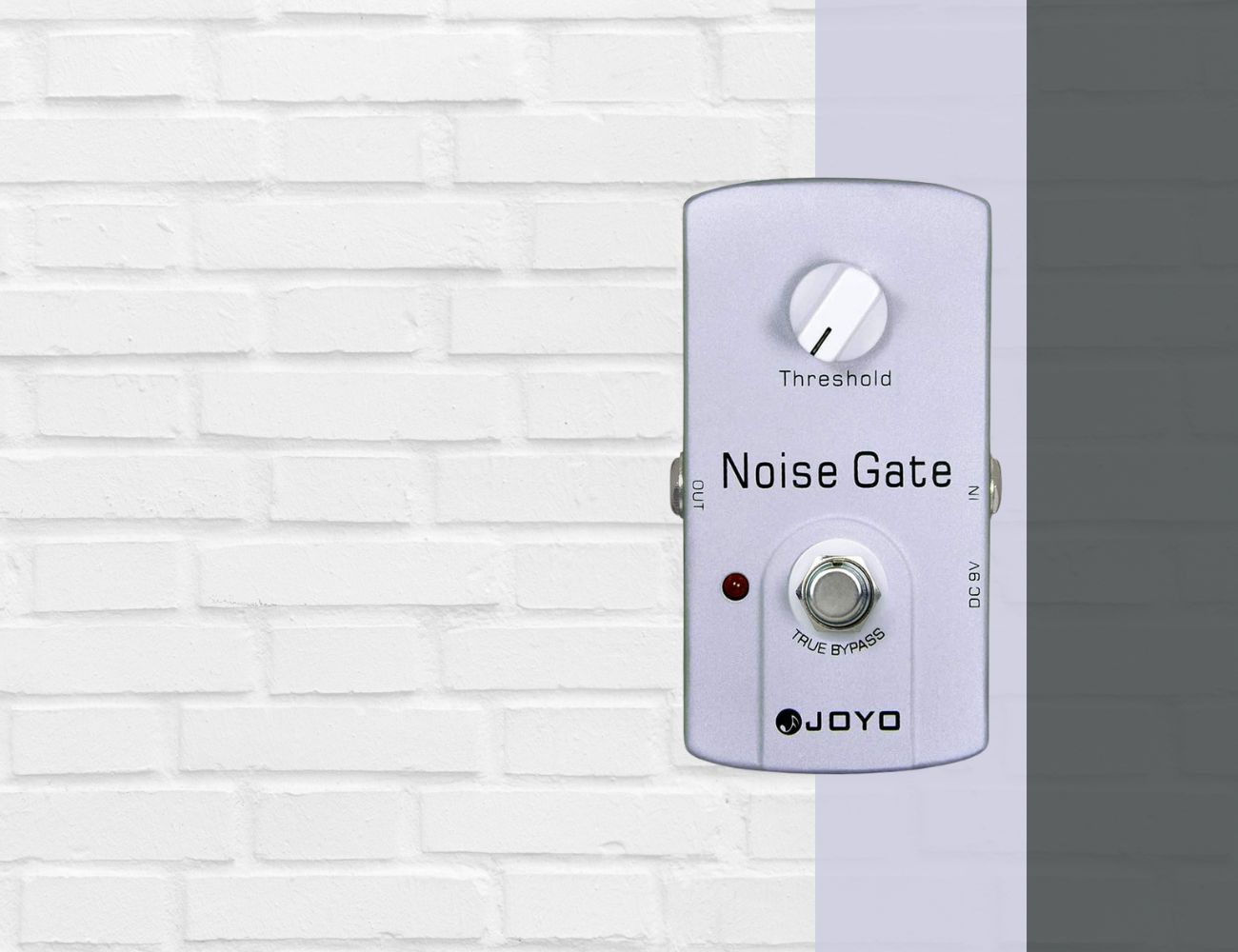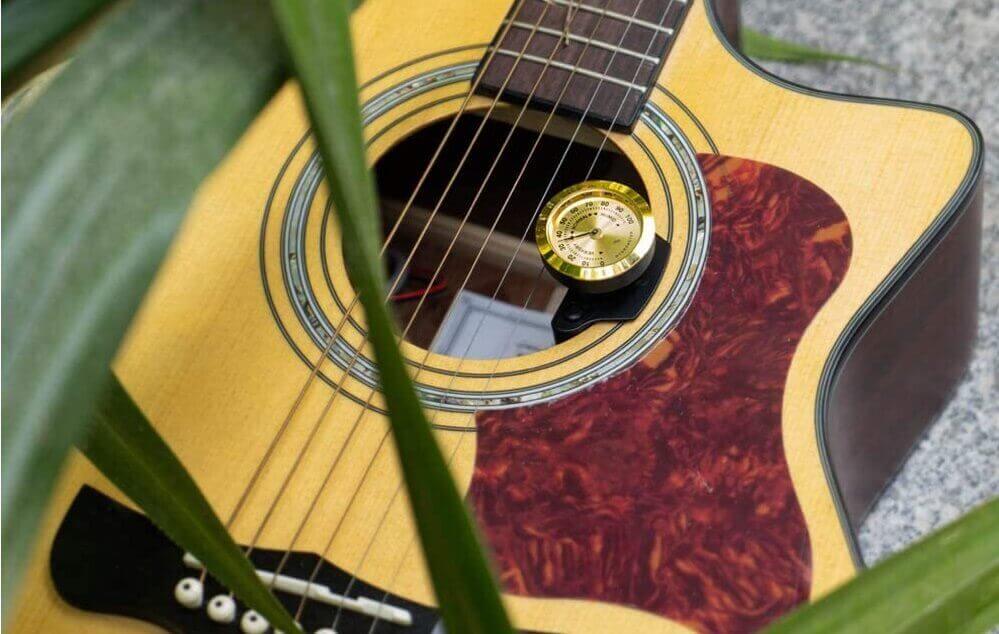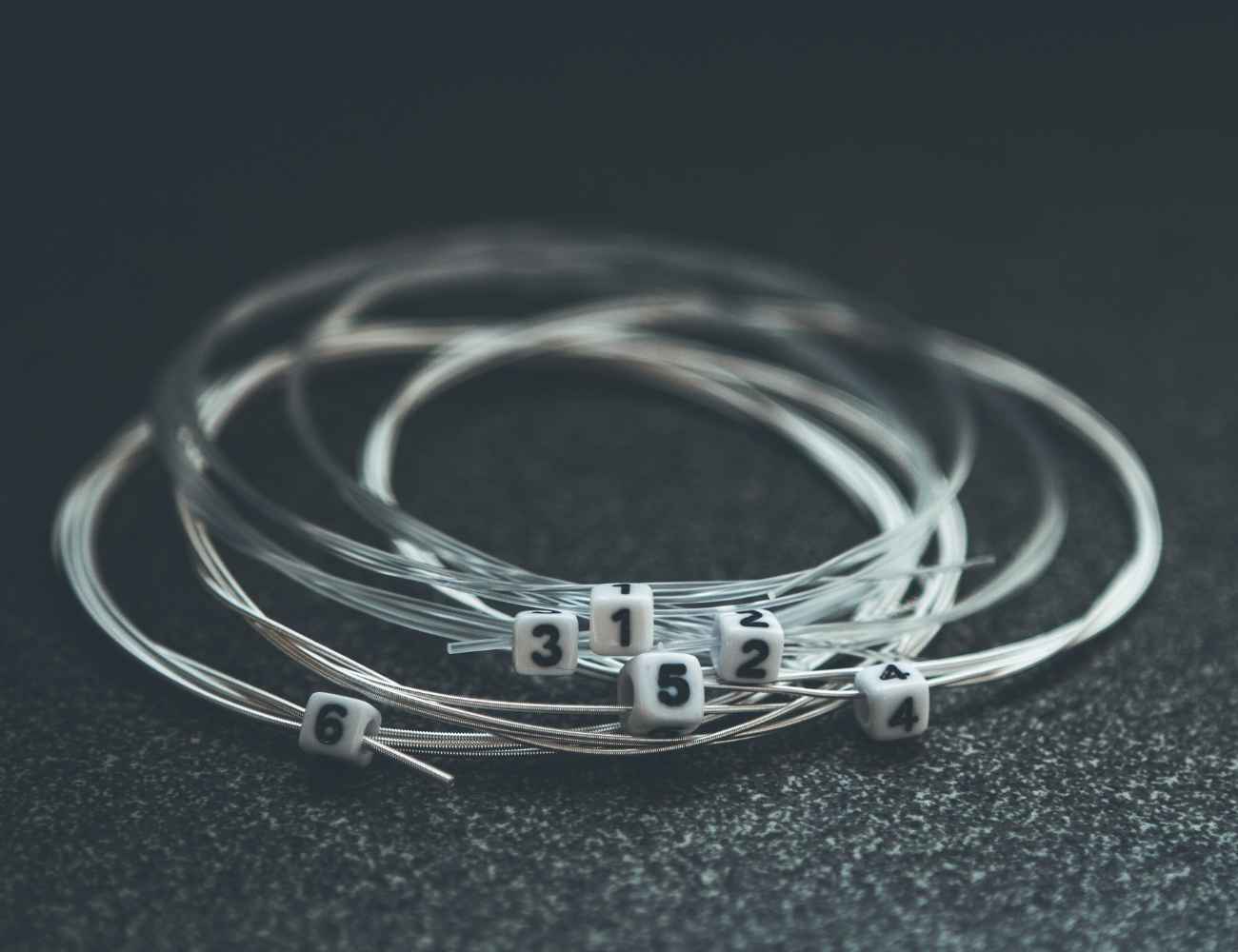Have you ever had your sweet guitar solo ruined by annoying background noise?
It might be time for you to get a noise gate pedal to help silence the unwanted buzz, keeping your music pure and focused.
In this post, I’ll dive deep into the world of the best noise gate pedals, ideal for both new and experienced musicians.
We’ll navigate through their benefits, how they function and even dish out top recommendations to consider.
Aside from that, I’ll also answer some of the most frequently asked questions on this topic so that you can have a better idea of what to expect when buying a new noise gate pedal.
Table of Contents
- Best Noise Gate Pedals
- Boss NS-2 Noise Suppressor Pedal
- TC Electronic SENTRY Noise Gate Pedal
- MXR Noise Clamp Noise Reduction Pedal
- Behringer NR300 Noise Reducer Pedal
- SONICAKE Noise Gate Effects Pedal
- Donner Noise Gate Pedal
- ISP Technologies Deci-Mate Micro Noise Gate Pedal
- Jim Dunlop Smart Gate Noise Gate Pedal
- JOYO Noise Gate Mini Pedal
- Movall MP-307 Noise Gate Guitar Effect Pedal
- AZOR Noise Gate Pedal
- Pigtronix Gatekeeper Micro Noise Gate Pedal
- JOYO Noise Gate Effect Pedal
- Jim Dunlop Dyna Comp Guitar Effects Pedal
- ISP Technologies Decimator II Noise Reduction Pedal
- Stax Guitar Noise Gate Pedal
- MXR M235FC Smart Gate Pedal
- What exactly is a noise gate pedal?
- What should you consider when choosing a noise gate pedal?
- How to properly use a noise gate pedal?
- How to order pedals on a pedalboard?
- Boutique vs. Mass-Produced pedals
- How much should you spend on a guitar pedal?
- Can you use a guitar pedal with a bass guitar?
- How to properly power your pedals?
Best Noise Gate Pedals
Before I begin, here are my top selected choices:
Boss NS-2 Noise Suppressor Pedal

Legendary BOSS quality for reliable noise suppression. Check Price
|
|
AZOR Noise Gate Pedal

AZOR Noise Gate Pedal reduces noise for improved sound quality with two easy-to-control modes. Check Price
|
Boss NS-2 Noise Suppressor Pedal
Legendary BOSS quality for reliable noise suppression.
BOSS provides high-quality guitar effects, amps, and accessories, trusted by professional and amateur musicians alike. Their line-up of products offers sound, reliability, and inspiration to players of all levels.
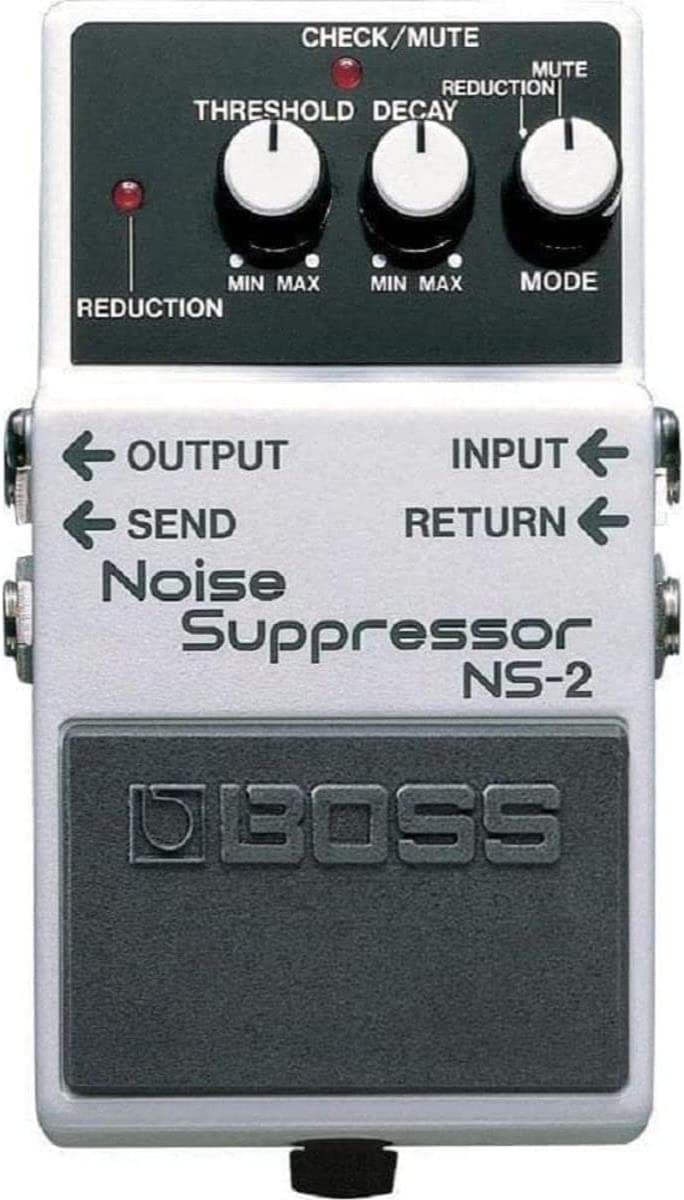
The Boss NS-2 Noise Suppressor Pedal is a little powerhouse perfect for shaping your guitar’s output.
Primarily, its goal is to limit and control any unwanted noise or interference without tampering with your desired tone.
Crafted with a built-in noise detection circuit, this device identifies and isolates disruptive sounds, a remarkable feature that helps you achieve a cleaner, more distinct sound.
Add to this the pedal’s send and return loops, allowing you to establish noise suppression levels for different aspects of your signal chain.
This pedal showcases a three-dial design, offering knobs for ‘Threshold,’ ‘Decay,’ and ‘Mode.’ The Threshold control lets you set the level at which the noise gate kicks in, whereas Decay adjusts how fast the gate closes.
Meanwhile, the Mode selector switch enables toggling between the ‘Mute’ and ‘Reduction’ settings.
Housed in Boss’ signature rugged enclosure, the NS-2 Noise Suppressor Pedal delivers reliable performance, a crucial aspect for any touring musician.
- My Review
Diving right into the heart of the matter, my time with the Boss NS-2 Noise Suppressor Pedal proved to be a revelation.
It’s like the unsung hero of my pedalboard, subtly working behind the scenes to provide a crisp and clean sound, cutting the noise out and leaving the good stuff in.
Now, let’s talk about setting it up.
With simple, intuitive controls for Threshold, Decay, and Mode, dialing in the perfect amount of noise suppression was a breeze.
The Threshold knob really lets you fine-tune when the noise gate springs into action, offering control over the pedal’s response.
The Decay knob, on the other hand, controls how quickly the gate shuts once your signal dips below the set threshold.
It’s remarkably responsive, providing a natural, unobtrusive quieting of your signal.
Something truly remarkable is the Mode selector switch.
Flip between ‘Reduction’ and ‘Mute’ with a single flick.
This subtle but significant feature allows for sound customization at an incredibly granular level.
‘Reduction’ mode quiets your signal, while ‘Mute’ offers a hard cut-off, making it perfect for those times when silence is golden.
In terms of build quality, we’re talking about Boss here – sturdy and designed for the long haul.
It feels as though it’s built to survive the rigors of life on the road.
Its compact design makes it an easy addition to any pedalboard without taking up too much space.
But no product is perfect, right?
One minor gripe I have is that this pedal requires a bit of trial and error to find the sweet spot for your particular setup.
This is not necessarily a deal-break overall, but it’s worth noting for those who prefer a plug-and-play experience.
Here are the ratings I’ll give to the Boss NS-2 Noise Suppressor Pedal:
My experience with the Boss NS-2 Noise Suppressor Pedal was overwhelmingly positive.
It’s a tool designed with precision and practicality in mind, delivering a cleaner, more focused sound that helps your guitar’s true voice sing out.
- Pros:
- Effectively reduces noise and hum
- Trusted brand with high-quality construction
- Useful for cleaning up sound in live performances
- Can be used in various positions in your effects chain
- Durable and long-lasting
- Cons:
- May slightly affect tone or harmonic overtones
- Not effective for all types of noise issues
- Learning curve for optimal setup and settings
- Noisy effects loop may require additional adjustments
- May not completely eliminate all types of noise
My final verdict is that the Boss NS-2 Noise Suppressor Pedal is highly recommended for guitarists looking to reduce noise and hum in their setup effectively.
With its trusted brand reputation, versatile features, and solid performance, it offers value for its price.
While it may slightly impact the tone and require some learning to optimize settings, its overall build quality and ability to clean up sound make it a valuable addition to any pedalboard.
TC Electronic SENTRY Noise Gate Pedal
TC Electronic SENTRY NOISE GATE offers seamless noise removal, hard-gate mode, and TonePrints for customizable effects.
SENTRY NOISE GATE is a cutting-edge multiband noise-gating pedal with Hard-Gate mode and TonePrints, allowing you to dial out unwanted noise and customize your sound with ease. Enjoy noise-free, fully dynamic performances with seamless and organic noise reduction.
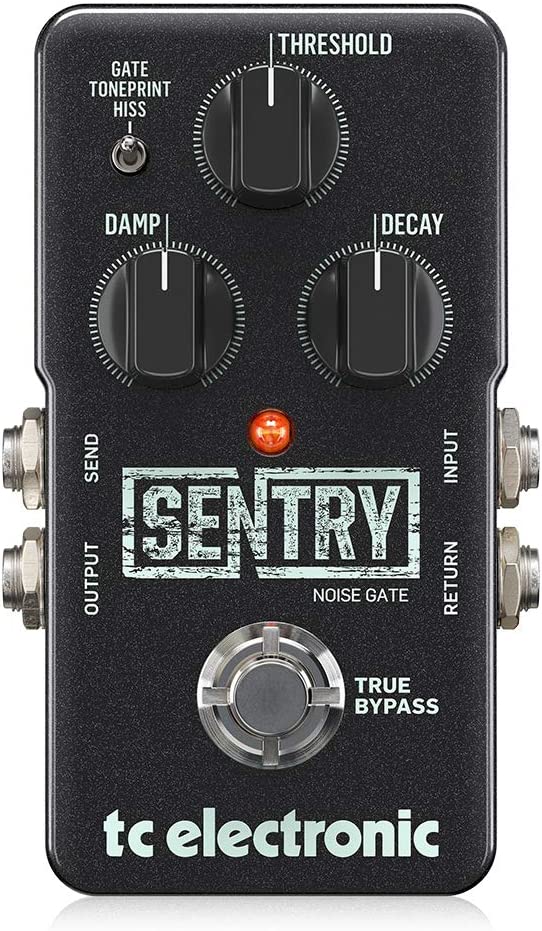
The TC Electronic Sentry Noise Gate Pedal it’s a potent tool designed to tackle noise issues in your guitar rig.
Its exceptional multiband technology drawn from TC Electronic’s System 6000 provides a nuanced approach to eliminating unwanted noise, surpassing traditional noise gates’ capabilities.
Interestingly, it can isolate and quiet individual frequencies, letting the wanted tones shine through unaffected.
Its flexible send/return loop is an equally exciting aspect, which allows your favorite pedals to integrate into the noise gate process.
For further customization, there’s the TonePrint feature.
It grants you access to a library of artist-created presets, providing a new dimension of tonal options.
The pedal’s robust design ensures durability, while its compact size is pedalboard-friendly.
Plus, its true bypass nature maintains the integrity of your tone when the pedal is off.
With all these features, the Sentry Noise Gate Pedal offers a dynamic solution for noise control.
- My Review
Diving right in, I first noticed the TC Electronic Sentry Noise Gate Pedal’s robust and durable construction.
A sense of reliability comes with this pedal, suggesting it can handle the rigors of regular gigging and travel.
Its compact size fits snugly on my pedalboard without cramping up the space for my other gear.
Using the pedal was an intriguing experience.
Its multiband technology is undoubtedly the heart and soul of this device, setting it apart from traditional noise gate pedals.
The finesse with which it handles noise reduction, isolating and muting unwanted frequencies while letting the desired tones pass through, is remarkable.
At no point did it feel like my tone was compromised or that the natural dynamics of my playing were hampered.
One particularly impressive feature I found was the flexible send/return loop.
Incorporating other pedals into the noise gate process is a big plus, allowing me to further refine my tone without any hassle.
This feature opens up a world of signal routing and noise control possibilities.
I also played around with the TonePrint functionality.
Accessing artist-created presets offers some exciting tonal options, though I must admit, I spent a lot of time exploring this feature to appreciate it fully.
However, there were moments when I found the interface slightly intimidating.
It’s not overly complex, but a beginner might need time to familiarize themselves with the controls.
On a final note, the true bypass nature of the pedal was appreciated.
Here are the ratings I’ll give to the TC Electronic SENTRY Noise Gate Pedal:
Knowing my tone remains pure when the pedal is disengaged is a real comfort.
My journey with the Sentry Noise Gate Pedal was pretty fascinating, and it’s a pedal I believe can greatly enhance any guitar rig with its exceptional noise control capabilities.
- Pros:
- State-of-the-art multiband and hard gate modes.
- Effective noise removal for clean signal.
- TonePrint enabled for customizable effects.
- True or buffered bypass for tonal integrity.
- Cons:
- Potential issues with encoders in software interface.
- Limited availability of TonePrint settings.
- Possible sensitivity and sustain concerns in certain setups.
- Reports of occasional malfunctions or switch issues.
My final verdict is that the TC Electronic SENTRY NOISE GATE pedal is a highly capable and versatile solution for noise reduction in guitar setups.
With its state-of-the-art multiband and hard gate modes, it effectively removes unwanted noise while maintaining tonal integrity.
The inclusion of TonePrint functionality allows for customization and access to signature effects.
While there have been some reports of minor issues with the software interface and occasional malfunctions, the overall performance and brand reputation of TC Electronic make this pedal a valuable investment for musicians seeking reliable noise-gating capabilities.
MXR Noise Clamp Noise Reduction Pedal
MXR Noise Clamp reduces noise up to 26dB with single-knob control.
MXR Noise Clamp reduces noise up to 26dB, providing hiss-free performance for your stomp pedals. The single trigger knob allows you to set the volume threshold for activation, and a green LED shows when the gate is on/off.
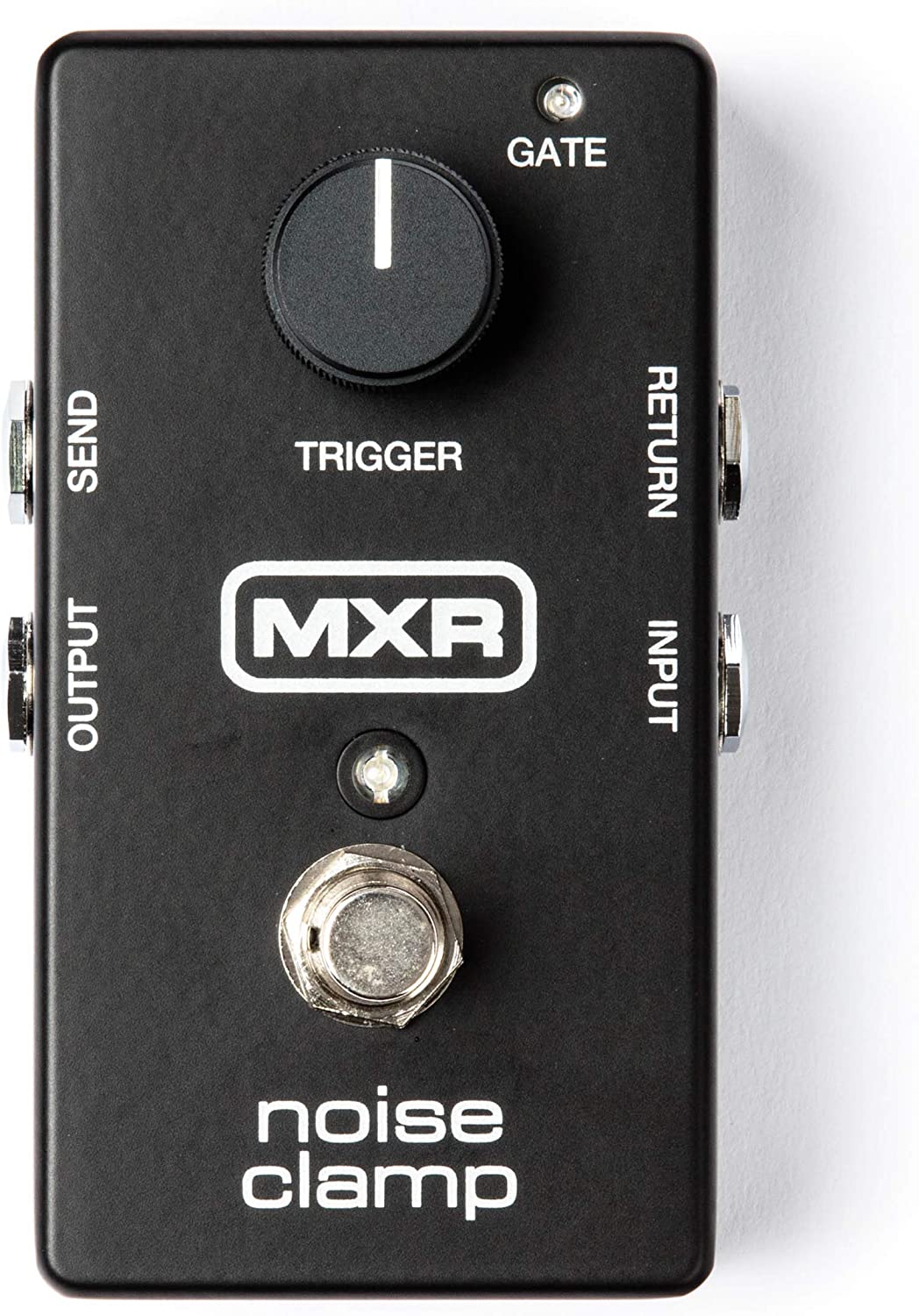
With the MXR Noise Clamp Noise Reduction Guitar Effects Pedal, you get an incredible tool for managing noise in your guitar effects chain.
Coming from the well-regarded MXR brand, based in New York and known for its quality effects pedals, this compact and sleek black unit promises to keep your sound clean and focused.
Its primary function is to eliminate any unwanted hiss or excessive noise that might affect your music.
This is accomplished through a sensitive trigger knob, which lets you precisely control the volume threshold at which the pedal activates.
A handy green LED indicates when the noise gate function is on or off.
Remarkably, this pedal can reduce noise by up to 26dB, allowing for crystal-clear riff definition even when your gain is cranked to the max.
Crafted with care in the United States, this pedal has an impressive built quality.
Its compact dimensions of 5.5 x 4.4 x 2.6 inches and just half a pound weight make it a handy addition to any pedalboard.
- My Review
Picking up this black, compact gadget, I couldn’t help but admire its robust build quality, a testament to MXR’s meticulous craftsmanship.
With dimensions of 5.5 x 4.4 x 2.6 inches and weighing a mere half pound, it nestled snugly into my pedalboard setup without a fuss.
Playing around with its single threshold trigger knob, I found it quite intuitive.
This knob is pivotal in setting the volume limit that activates the pedal, a feature that allows for significant control over noise reduction.
But what surprised me was its remarkable ability to slash noise by up to 26 dB, even when I pushed my gain levels to the edge.
Simultaneously, I felt my riff definition was unblemished, shining through with utter clarity.
That was a major win, especially because most noise reduction pedals tend to compromise on sound quality at high gain levels.
A glance at the pedal’s green LED light let me know if the noise gate function was on or off, an easily accessible visual cue that I found particularly helpful during fast-paced jam sessions.
But where this pedal left its mark was its ability to restrain unwanted hiss or excessive noise.
It felt like having a vigilant guard on duty, constantly monitoring and keeping the unwanted noise intruders at bay.
Of course, no product is without its quirks.
The MXR Noise Clamp could potentially be a little complex for novices.
The absence of an instruction manual could make the initial setup challenging for some.
However, once you get past that minor hurdle, it’s smooth sailing with this noise reduction champion.
Here are the ratings I’ll give to the MXR Noise Clamp Noise Reduction Pedal:
In my books, the MXR Noise Clamp has earned its place as a reliable addition to any guitar enthusiast’s collection.
It’s a promising blend of functionality, performance, and design, poised to elevate your musical journey.
- Pros:
- Reduces excess noise by up to 26 dB
- Maintains riff definition at extreme gain levels
- Compact size for easy integration into pedalboard
- Cons:
- May slightly affect the tone or dynamics
- Only has a single threshold trigger knob
- Not suitable for all types of musical genres
My final verdict is that the MXR Noise Clamp Noise Reduction Guitar Effects Pedal is a solid choice for guitarists looking to reduce excess noise in their effects chain.
Its ability to reduce noise by up to 26 dB and maintain riff definition at extreme gain levels offers good performance and functionality.
The compact size makes it convenient for integration into a pedalboard.
Additionally, the MXR brand is well-known and respected in the industry.
While it may slightly affect the tone or dynamics and has a single threshold trigger knob, it provides value for its intended purpose overall.
Behringer NR300 Noise Reducer Pedal
Noise-free single-coil tone with the NR300.
The NR300 Noise Reducer eliminates hum from single-coil pickups while preserving attack and envelope. It functions as two pedals in one, with adjustable Threshold and Decay and a Mute mode, plus an added Send/Return loop for external effect units. Easy to use with LED indicators and a noise-free on/off switch.
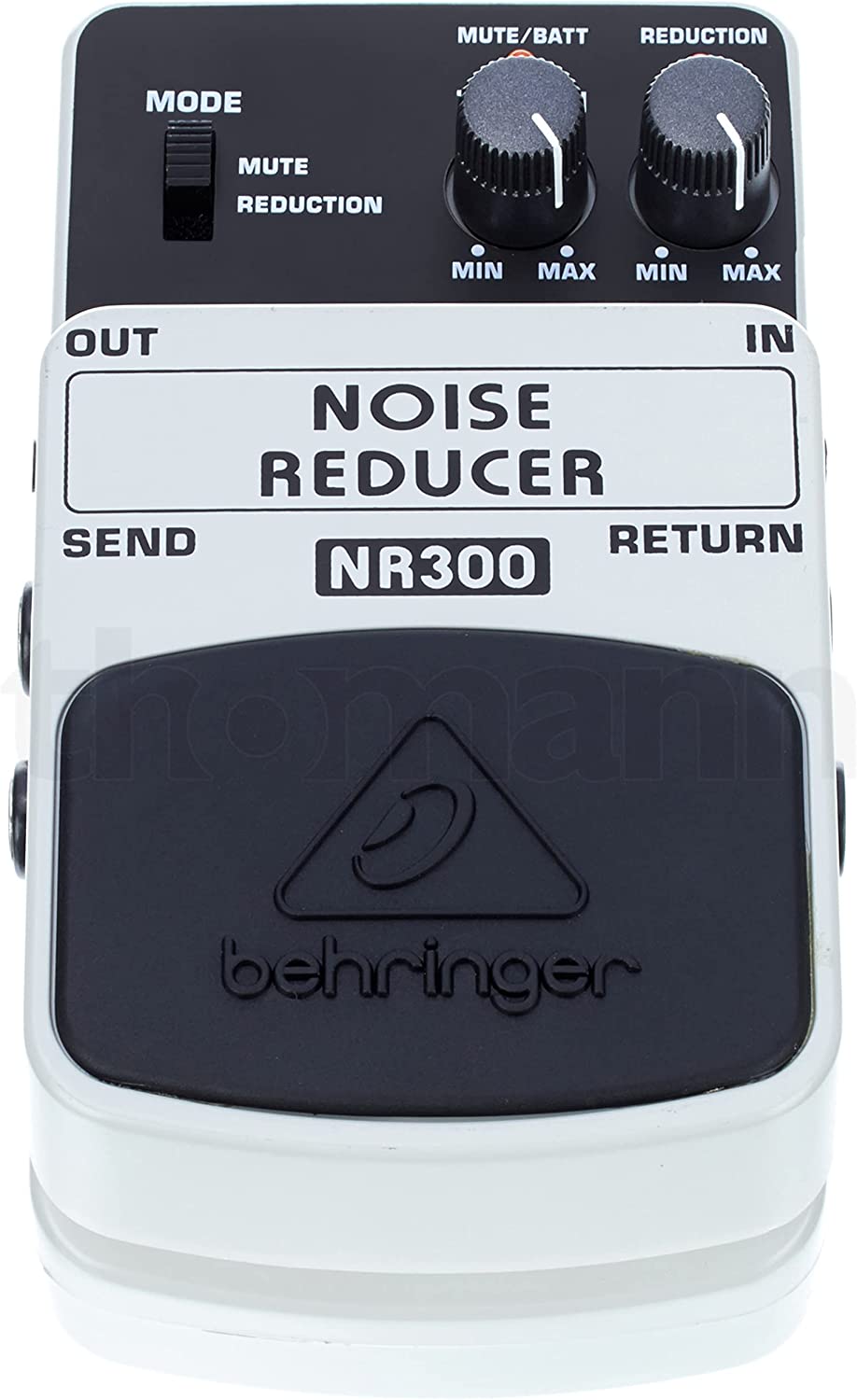
The Behringer NOISE REDUCER NR300 is a noise reduction effects pedal designed to eliminate unwanted noise and hum from your guitar signal without altering its tone.
This compact pedal is crafted to compete with the leading products in the market, offering both high-quality performance and affordability.
With dedicated Threshold and Decay controls and a Mute mode, you can easily adjust the pedal to your liking, ensuring your playing dynamics remain intact.
Furthermore, the NR300 has an additional Send/Return loop that allows you to suppress noise from external effect units.
The pedal is housed in a black and silver color, lightweight plastic casing measuring 2.76 x 2.13 x 4.84 inches and weighing 0.73 pounds.
It’s powered by a 9V battery or a compatible DC power supply (not included) and features a first-class electronic On/Off switch for precise signal integrity in bypass mode.
Conceived and designed by Behringer in Germany, the NR300 is a practical solution for musicians seeking noise reduction without breaking the bank.
- My Review
After spending some time with the Behringer NOISE REDUCER NR300, I can confidently say that it’s a decent noise reduction effects pedal for musicians looking to tackle unwanted noise and hum in their signal chain.
Firstly, I found that the NR300 worked effectively for noise reduction and preserving the original attack and envelope of my playing.
The dedicated Threshold and Decay controls allowed me to fine-tune the pedal to eliminate noise without compromising my tone.
One of the standout features of the NR300 is the Mute mode, which essentially functions as a kill switch.
This was a handy addition during performances when I needed to switch off the signal quickly.
Also, I appreciated the Send/Return loop, which is perfect for suppressing noise from external effects units.
However, there are some areas where the NR300 could be improved.
The plastic construction didn’t bother me too much, given its affordable price point, but I can’t help but think that a more robust metal enclosure would have been a better choice.
Furthermore, the lack of a power supply in the package was a tiny inconvenience, as I needed to purchase one separately or rely on a 9V battery.
Here are the ratings I’ll give to the Behringer NR300 Noise Reducer Pedal:
I may also point out that while the NR300 worked well in most instances, there were times when I noticed slight signal degradation.
It’s not a deal-breaker, but it can be a drawback for musicians who demand absolute signal purity.
- Pros:
- Effectively eliminate unwanted noise and hum
- Preserves original attack and dynamics
- Mute mode for flexibility
- Additional send/return loop for noise suppression
- Compact and lightweight
- Cons:
- Plastic construction
- No power supply included
- Possible signal degradation
My final verdict is that the Behringer NOISE REDUCER NR300 Ultimate Noise Reduction Effects Pedal is a solid option for musicians looking to eliminate unwanted noise and hum from their signal chain.
Despite its plastic construction and potential signal degradation, this pedal offers effective noise reduction, preserved attack and dynamics, and flexibility with its mute mode and send/return loop.
With a competitive price point, it provides good value for its features and performance.
SONICAKE Noise Gate Effects Pedal
SONICAKE’s Sonic Aby Box provides flexible signal routing with two modes and true bypass footswitch.
Sonic ABY is a compact, durable, dual-mode True Bypass ABY switcher for flexible signal routing. Easily toggle between A/B mode or Y=A+B mode with the Mode Selector switch. Includes a heavy-duty metal footswitch and on/off status LED.
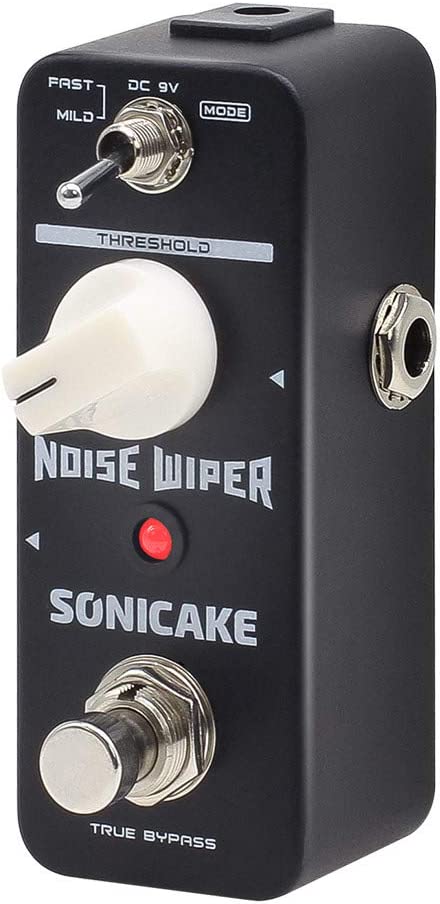
Sonically speaking, the Noise Gate Effects Pedal from SONICAKE is a pretty impressive piece of kit.
At its heart is a high-fidelity circuit that effectively suppresses any unwanted background noise from your guitar.
This pedal’s true bypass capability ensures the integrity of your guitar’s signal, keeping your original tone intact.
The pedal’s size is compact, perfect for any pedalboard layout.
Despite its small footprint, it still boasts a durable metal construction, promising to stand the test of time from the studio to the stage.
Its operation is as straightforward as, with a single control knob for ease of use.
Twist that knob to fine-tune your sound – from soft hiss elimination to full-on noise reduction.
The pedal indicates the power and gate statuses and is fitted with LEDs. AIt’s standard 9V DC power supply powers it.
So, when dialing in your tone without distracting noise, SONICAKE’s Noise Gate Effects Pedal is worth a serious look.
- My Review
Having tested the SONICAKE Noise Gate Effects Pedal, I must say it delivers as promised.
THE DIFFERENCE WAS PALPABLE once I hooked it up – all the pesky buzz and hum that used to be there vanished, and I was left with a crisp, clean guitar tone.
In a way, it felt like somebody had cleaned my audio glasses.
Manipulating the knob, I could fine-tune the noise suppression level.
This fine control is something I found truly advantageous.
I could keep the softer ambiances intact while stomping out the loud, jarring noise.
It was not just an off or on switch but a precise noise control dial.
The size of this pedal also appealed to me.
Despite its small stature, the SONICAKE Noise Gate was sturdily built.
Its metal construction had a reassuring weight to it – a little powerhouse that was up for the rigors of the road.
Now, its true bypass feature lived up to its billing.
My tone did not lose any character or become thin, even when the pedal was switched off.
That integrity of sound is something I appreciate about this pedal.
The LEDs are a thoughtful addition, providing me with instant visual feedback on power and gate statuses.
This was handy in darker settings where visual cues are often hard to come by.
In terms of power, it uses a standard 9V DC power supply, making it compatible with most pedal power systems.
I found this very convenient as I could integrate it into my existing setup without hassle.
Here are the ratings I’ll give to the SONICAKE Noise Gate Effects Pedal:
It’s safe to say the SONICAKE Noise Gate Effects Pedal exceeded my expectations.
It delivered excellent noise suppression, maintained the integrity of my tone, and managed to do all that in a small, road-ready package.
- Pros:
- Flexible signal routing
- True bypass for clean signal path
- Works with 9V center-negative power supply
- Sturdy and durable construction
- Allows A/B signal route switching
- Cons:
- Requires external power supply (not included)
- Limited control options (e.g., no volume control)
- Potential tone loss in Y mode
- Some users reported noise issues
- Small and hard-to-read text on the pedal
My final verdict is that the SONICAKE Sonic Aby Box Line Selector Ab Switch Aby Pedal Mini Guitar Effect Pedal True Bypass is a highly versatile and feature-rich pedal with good tone and performance.
The brand’s commitment to creating quality musical instruments and accessories is evident in this product.
With its affordable price point, it offers great value for both studio recording and live performances.
However, some minor drawbacks exist, such as the need for an external power supply and potential noise issues.
It is a solid choice for guitarists seeking flexible signal routing and reliable performance.
Donner Noise Gate Pedal
Noise gate pedal with two modes and true bypass for electric guitars and basses.
The Donner Noise Gate is an easy-to-use and efficient noise gate pedal, offering two practical modes and sensitive yet smooth sound control. It features a Threshold knob, an LED to indicate when the effect is on, and a footswitch for easy on/off operation. Perfect for reducing unwanted noise in your guitar or bass signal.
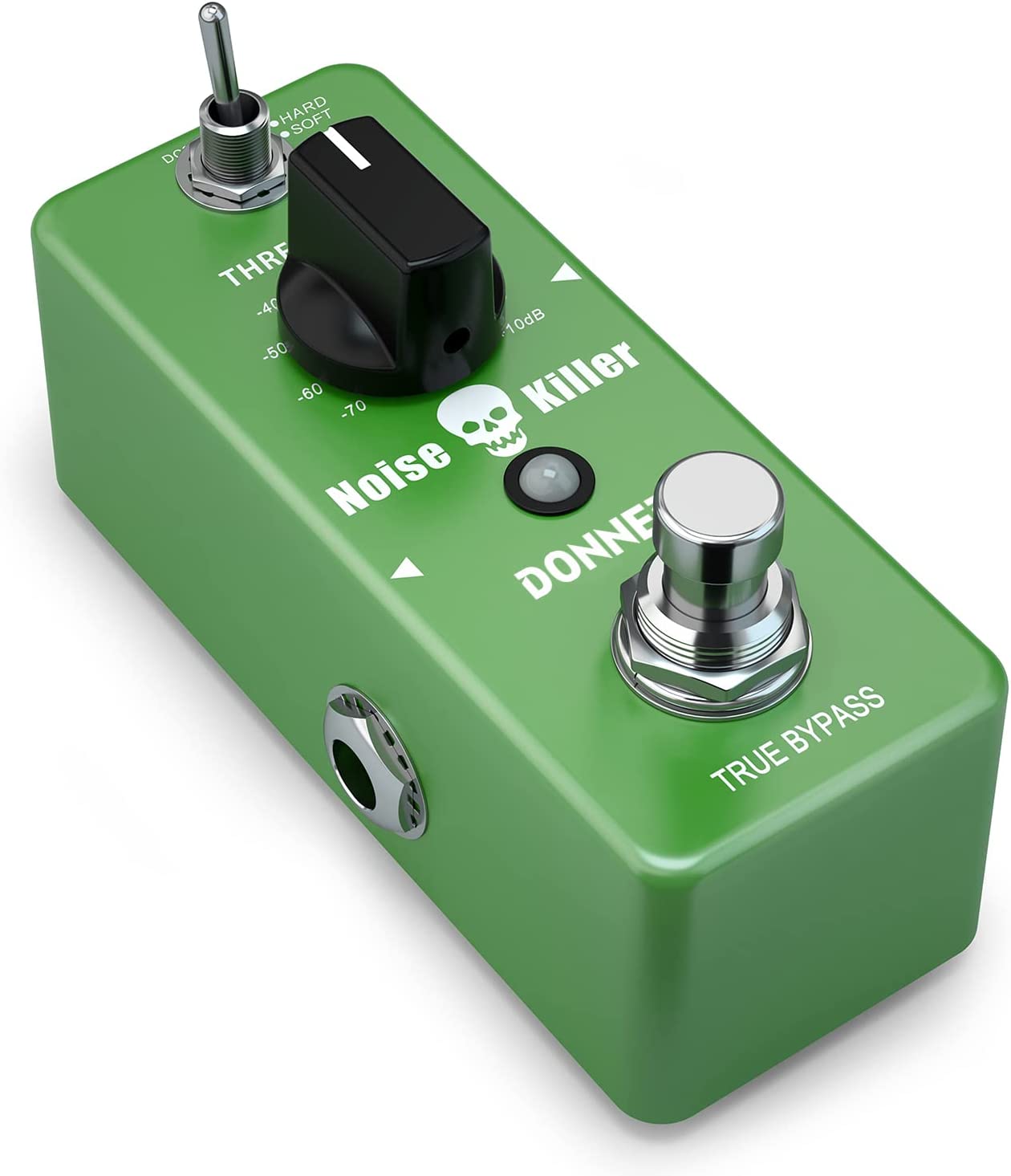
If you’re seeking a noise gate pedal to help tame unwanted noise from your electric guitar or bass, the Donner Noise Gate Pedal has you covered.
This compact device offers two modes – hard and soft- giving you a choice between faster, harder noise reduction and a smoother experience.
Adjusting the noise reduction range from -70 to +10dB, you can dial a near-perfect sound.
One key feature of this pedal is its true bypass, which ensures a transparent tone when disengaged.
A word of caution, though – a DC 9V adapter for the power supply is not included, so you’ll need to purchase one to use the pedal.
Designed by Donner, a brand well-known for its affordable and quality musical instruments and accessories, this green Noise Gate pedal boasts a compact style.
The dimensions are 5 x 2 x 2 inches, weighing 230 grams, making it an easy fit on any pedalboard.
With the Donner Noise Gate Pedal, you can achieve a cleaner, more controlled sound for your guitar and bass performances.
- My Review
I recently had the opportunity to try out the Donner Noise Gate Pedal, and I must say, it certainly impressed me.
With a primary focus on reducing unwanted noise from my electric guitar and bass, this pedal proved to be a game-changer for my performances.
What first caught my attention was the pedal’s compact and sleek design, making it a breeze to fit on my pedalboard.
Coming in a vibrant green color, the Donner Noise Gate Pedal is not only visually appealing but also offers a great deal of control over my sound.
One significant aspect I appreciated was the inclusion of two distinct noise gate modes – hard and soft.
The hard mode offers aggressive noise reduction, while the soft mode provides a gentler, more subtle approach.
With a noise reduction range of -70 to +10dB, I enjoyed the ability to tailor the pedal’s responsiveness to my specific playing needs.
The true bypass feature is another noteworthy function, ensuring a transparent tone when the pedal is disengaged.
However, remember that the pedal does not have a DC 9V adapter for its power supply, so I had to purchase one separately before using it.
During my time with the Donner Noise Gate Pedal, I noticed a significant improvement in the clarity and control of my guitar and bass sounds.
While the pedal does require careful adjustment to achieve the optimum gate setting and preserve sustain, its overall effectiveness and affordability make it well worth the effort.
One minor drawback I faced was the pedal’s bottom surface not adhering well to the Velcro on my pedalboard.
Here are the ratings I’ll give to the Donner Noise Gate Pedal:
However, this issue can be overcome with other securing methods.
In my experience, the Donner Noise Gate Pedal is a valuable addition to any musician’s setup, offering effective noise reduction and versatile control, all within a compact and stylish package.
- Pros:
- Affordable price.
- Sturdy construction.
- Effective noise reduction.
- Cons:
- Power supply not included.
- Velcro adhesion issues.
- Sensitive settings adjustments.
My final verdict is that the Donner Noise Gate Pedal is an affordable, versatile, and effective noise-reduction solution for electric guitar and bass players.
Despite minor drawbacks, such as the lack of a power supply and Velcro adhesion issues, its compact design, customizable noise reduction options, and overall performance make it a worthy addition to any musician’s setup.
ISP Technologies Deci-Mate Micro Noise Gate Pedal
Noise reduction in a compact pedal for superior tracking.
Red Witch’s DeciMate is a micro-sized noise reduction pedal that offers superior tracking and true bypass switching. It also features adjustable threshold and release time, as well as a LED indicator to monitor performance.
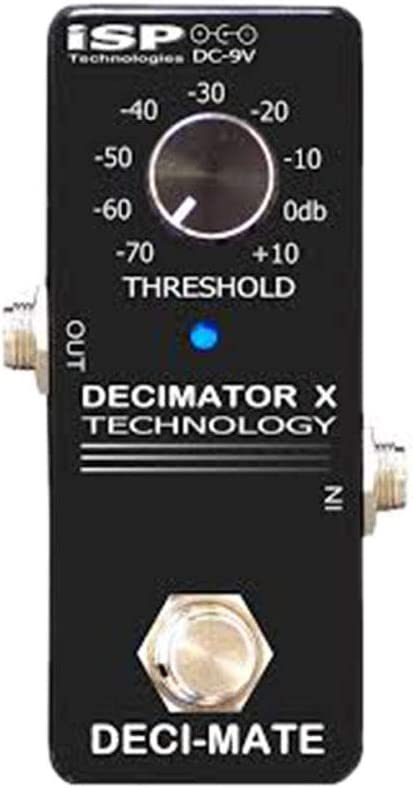
Meet the Deci-Mate Micro Noise Gate Pedal by ISP Technologies.
It’s small, looks great, and has a black finish.
Its micro-sized dimensions – about 5.45 by 3.95 by 2.4 inches – make it an ideal fit for even the most packed pedalboards.
Despite its minimal weight of just 0.01 ounces, it packs a punch with its adaptive tracking feature, expertly reducing unwanted guitar noise.
Known as a Decimator, it’s a top-tier noise gate in a convenient, petite package.
One of its major draws is the single-knob design, making it a breeze to dial out the pesky noise often associated with high-gain play.
It is simple yet effective and designed for use at the beginning of your effects chain to effectively combat excess noise, ensuring your guitar’s true sound shines through.
This little black box is worth a close look for those seeking a no-frills, high-quality noise gate.
- My Review
The Deci-Mate Micro Noise Gate Pedal from ISP Technologies certainly leaves an impression regarding guitar noise reduction.
Holding it in my hands, I appreciated its compactness and lightness – weighing a mere 0.01 ounces, it’s a featherweight.
Its design fits nicely into any setup, with its jet-black finish adding a touch of sophistication.
Now, plugging it in and dialing it to work is a breeze, thanks to the straightforward single-knob operation.
Less time fiddling with settings means more time to play!
The real surprise, however, lies in its performance.
It’s not your run-of-the-mill noise gate; this little dynamo demonstrates superior tracking, a highly efficient function in reducing those irritating guitar noises.
High-gain players, brace yourselves – this pedal does a commendable job of eliminating that grating hiss that frequently accompanies high-gain levels.
My hard rock riffs flowed smoothly, uninterrupted by any unwanted noises.
Yet, it must be noted that a hint of hiss was detectable when the pedal was in use.
It was a minor trade-off for overall clean performance, but still worth mentioning.
One feature that stood out was how effectively the pedal ceases noise when you stop playing.
It worked like a charm, quickly and efficiently, ending the sound that felt crisp and professional.
On the downside, its performance seemed to falter with very high gain levels.
While the Deci-Mate may not be the best noise gate in the market, it surely holds its ground, especially considering its size and price.
Here are the ratings I’ll give to the ISP Technologies Deci-Mate Micro Noise Gate Pedal:
Its robust features and impressive performance easily outshine its shortcomings.
Sure, it’s not perfect, but then again, what is?
- Pros:
- Compact size
- Effective noise reduction
- Simple single-knob operation
- Works well for high-gain setups
- Good value for the price
- Cons:
- Possible hiss when activated
- May not work as well with extremely high gain
- Lacks advanced customization options
My final verdict is that the ISP Technologies Deci-Mate Micro Noise Gate Pedal is a solid choice for guitarists seeking a compact and effective noise reduction solution.
Its small size and simple single-knob operation offer convenience and ease of use.
The positive reviews highlight its ability to effectively reduce noise, especially in high-gain setups.
However, there are some mentions of potential hiss when the pedal is active, and it may not provide advanced customization options for those seeking more control over their tone.
Considering its brand reputation and good value for the price, it is a recommended option for guitarists needing a reliable noise gate pedal.
Jim Dunlop Smart Gate Noise Gate Pedal
MXR-designed Jim Dunlop Smart Gate Noise Gate for precise noise reduction.
This MXR Smart Gate pedal reduces noise and hum from your signal, allowing for maximum detail and sustain to come through. Three selectable types of noise reduction handle any signal, and it activates quickly with its precise threshold trigger.
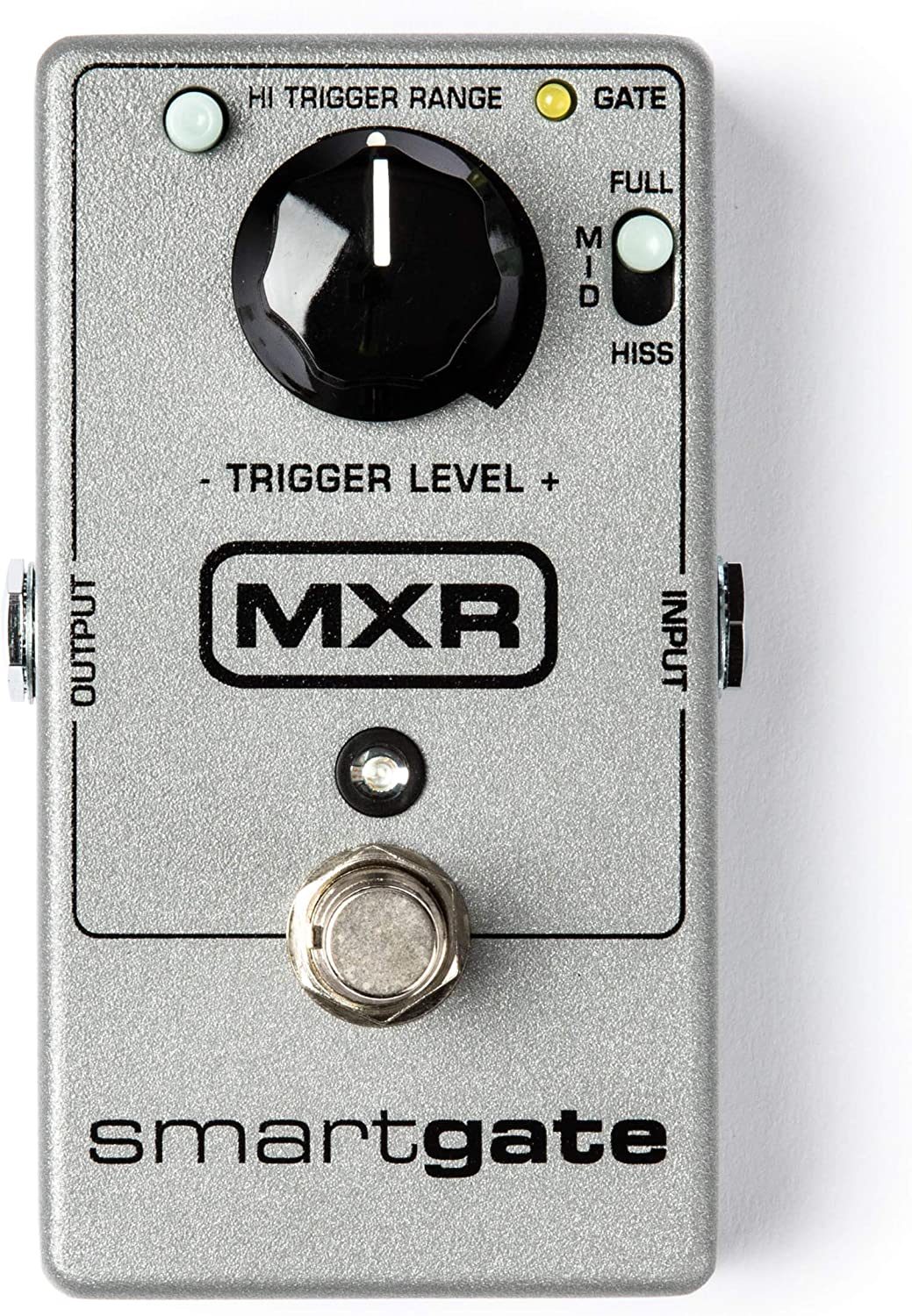
Meet the Jim Dunlop Smart Gate Noise Gate Pedal, a music world game-changer recognized for its three distinctive noise reduction ranges.
Suited to react differently to sustained notes versus quick, syncopated ones, this compact and sturdy gadget shows off an incredibly fast attack time, preserving the beauty of your picking transients and harmonic overtones.
Crafted with a precise threshold trigger and impressively clean circuitry, it can tame a roaring high-gain amp or quiet down a string of stompboxes.
Black in color, this modestly-sized unit is undeniably travel-friendly, measuring 5.8 by 4.5 by 2.8 inches and weighing just one pound.
This ingenious creation comes from the house of MXR, a renowned New York-based manufacturer, now a part of the Jim Dunlop brand.
Aptly identified by its model number M135, this pedal is a worthy companion for musicians desiring to maximize their performance while keeping unwanted noises at bay.
- My Review
Upon unboxing the Jim Dunlop Smart Gate Noise Gate Pedal, I was instantly taken by its compact, black, and sturdy build.
Weighing in at just a pound, this pedal is incredibly portable.
I was intrigued by its three distinct noise reduction ranges – a feature that promised much and, as I would soon discover, delivered even more.
Plugging it into my rig, I quickly found it had a rather intuitive way of reacting to the notes I played.
On slow, sustained notes, the pedal was more leisurely, preserving the true essence of my performance.
On the other hand, fast, syncopated notes saw it spring into action, cutting out noise with precision and speed.
One aspect that truly stood out was the fast attack time.
I maintained my picking transients and harmonic overtones, a critical feature for those of us who value the authenticity of the sound.
As I experimented, I discovered the pedal’s uncanny ability to distinguish between wanted and unwanted sound, allowing my chords to resonate while quelling any excess hiss.
Despite the praise, I should mention a few criticisms.
Although it efficiently handled the noise from my setup, I found the threshold trigger a bit fiddly.
A gentle adjustment often distinguishes between an overly gated sound and unwanted noise sneaking in.
So, getting used to and finding that sweet spot requires some time.
Additionally, while the pedal effectively managed high-gain noise, it struggled slightly with some single-coil hum and certain types of background noise.
As a result, it might not be effective for all setups or musical styles.
Nevertheless, my experience with the M135 Smart Gate was largely positive.
Here are the ratings I’ll give to the Jim Dunlop Smart Gate Noise Gate Pedal:
Even with a few hiccups, it provided an impressive noise reduction solution without compromising my tone or the nuances of my playing.
A welcome addition to any pedalboard, it’s an effective tool for tackling noise smartly and simply.
- Pros:
- Effective noise reduction
- Works well with various instruments
- Easy to use and set up
- Compact and sturdy build
- Retains guitar tone
- Cons:
- May not eliminate all background hum
- Can affect tone if settings are extreme
- Some users experienced LED malfunctions
- Not as effective with high-gain setups
- Doesn’t work well in all rig configurations
My final verdict is that the Jim Dunlop Smart Gate Noise Gate is a reliable and effective noise-reduction pedal with solid features and performance.
It offers versatility in handling different instruments and music genres.
The pedal retains the guitar’s tone and provides good sustained control.
The compact and sturdy build adds to its durability.
While it may not eliminate all background hum, and extreme settings can affect the tone, overall, it delivers satisfactory results.
The MXR brand, known for its quality, adds to its credibility.
Considering its reasonable price, the Smart Gate offers good value for money.
JOYO Noise Gate Mini Pedal
JOYO Noise Gate Mini Pedal: professional sound, easy setup, and rock-ready.
JOYO’s IRONMAN Series is perfect for guitarists looking for a reliable mini effect pedal with an innovative knob guard and time moderation technology for a natural sound with minimal tonal loss. The black shell also hides settings and can easily be wiped clean.
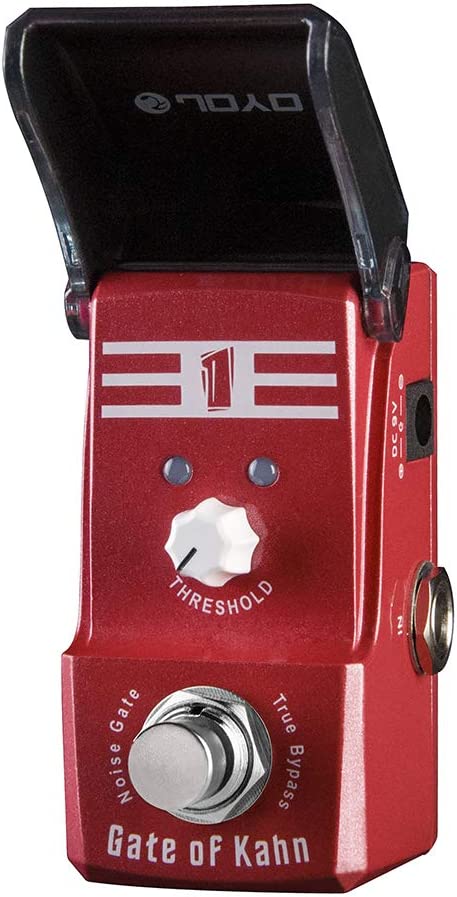
Crafted by JOYO, the Ironman Series Gate of Kahn JF-324 is an innovative noise gate pedal for electric guitars.
Its compact, mini size packs a punch, effectively silencing unwanted noise in your signal chain.
Despite its simplicity, boasting a singular ‘threshold’ control, this device expertly tailors your sound, ensuring the volume remains consistent whether the pedal is active.
At the heart of this noise gate lies cutting-edge VCA technology, offering a speedy response time that handles low-input signals with great subtlety.
This way, the natural resonance of your notes isn’t sacrificed, preserving the authentic tone of your guitar.
One remarkable feature is the ‘Knob-Guard,’ a protective cover that protects your settings from accidental changes.
Also noteworthy is the recommendation to use a JOYO original power adapter, or a reliable alternative, to prevent unexpected noise.
Despite its petite size, it measures 2.87 x 1.97 x 1.69 inches and weighs 220 grams, ensuring it’s sturdy and built to last.
- My Review
Jumping right into it, the moment I laid hands on the JOYO Noise Gate Mini Pedal, I felt a spark.
Its compact, mini form seemed almost contradictory to the robust and substantial feel it radiated.
Clad in an aesthetic blend of red and black, it carried the promise of performance.
But it was its functionality that truly stole the show.
With a simplicity that belied its sophisticated engineering, this noise gate pedal sported just one ‘threshold’ control.
Mastering it was a breeze and, honestly, quite satisfying.
It responded swiftly to my commands, maintaining a consistent volume level whether the pedal was engaged or not, and all this while elegantly eliminating unwanted noise from my guitar signal.
Speaking of noise elimination, I was taken aback by how subtly and effectively it handled low input signals.
My guitar notes rang out naturally, and the JOYO pedal did not interfere with the authentic guitar sound.
A silent warrior, it rooted out noise in the background, making for a clearer, sharper musical output.
A standout feature was the ‘Knob-Guard.’ Its innovative design concept ensured that my settings stayed intact, immune to any accidental changes – quite a thoughtful addition, I must say.
Being a meticulous person, I made sure to use the JOYO original power adapter and was glad to notice the absence of unexpected noise.
Despite its diminutive size, this pedal seemed to be a hardy device, built to endure the rigors of regular use.
Here are the ratings I’ll give to the JOYO Noise Gate Mini Pedal:
One minor note, though: for those new to using noise gate pedals, getting the ‘threshold’ setting just right might need some getting used to.
However, once you’ve got it down, the JOYO Noise Gate Mini Pedal promises to be an indispensable part of your music gear, one that you’d likely miss were it to go missing from your setup.
- Pros:
- Simple and easy to use
- Quick response time
- Preserves original guitar sound
- Effective noise reduction
- Compact and pedalboard-friendly
- Cons:
- Potential compatibility issues with certain setups
- No power supply or cable included
- Limited control with only one threshold adjustment
My final verdict is that the JOYO Noise Gate Mini Pedal, Gate of Kahn JF-324, is highly recommended for guitarists seeking an affordable and effective noise reduction solution.
With its simple and intuitive design, quick response time, and preservation of the original guitar sound, it promises to eliminate unwanted noise from your signal chain.
The compact size and durable construction make it pedalboard-friendly, and the positive customer reviews highlight its value and performance.
While there may be minor limitations in control options and potential compatibility issues, the overall versatility, features, tone, performance, brand reputation, and value make this noise gate pedal a worthwhile addition to any guitarist’s setup.
Movall MP-307 Noise Gate Guitar Effect Pedal
Noise-killing mini pedal with true bypass and adjustable sensitivity.
This mini-sized noise gate pedal is designed to reduce hum and buzz in your pedal chain. It features 2 knobs and a two-way selector switch for controlling the sensitivity and volume cut. Compatible for most guitars and basses, it is durable and stable with a slip-resistant bottom.
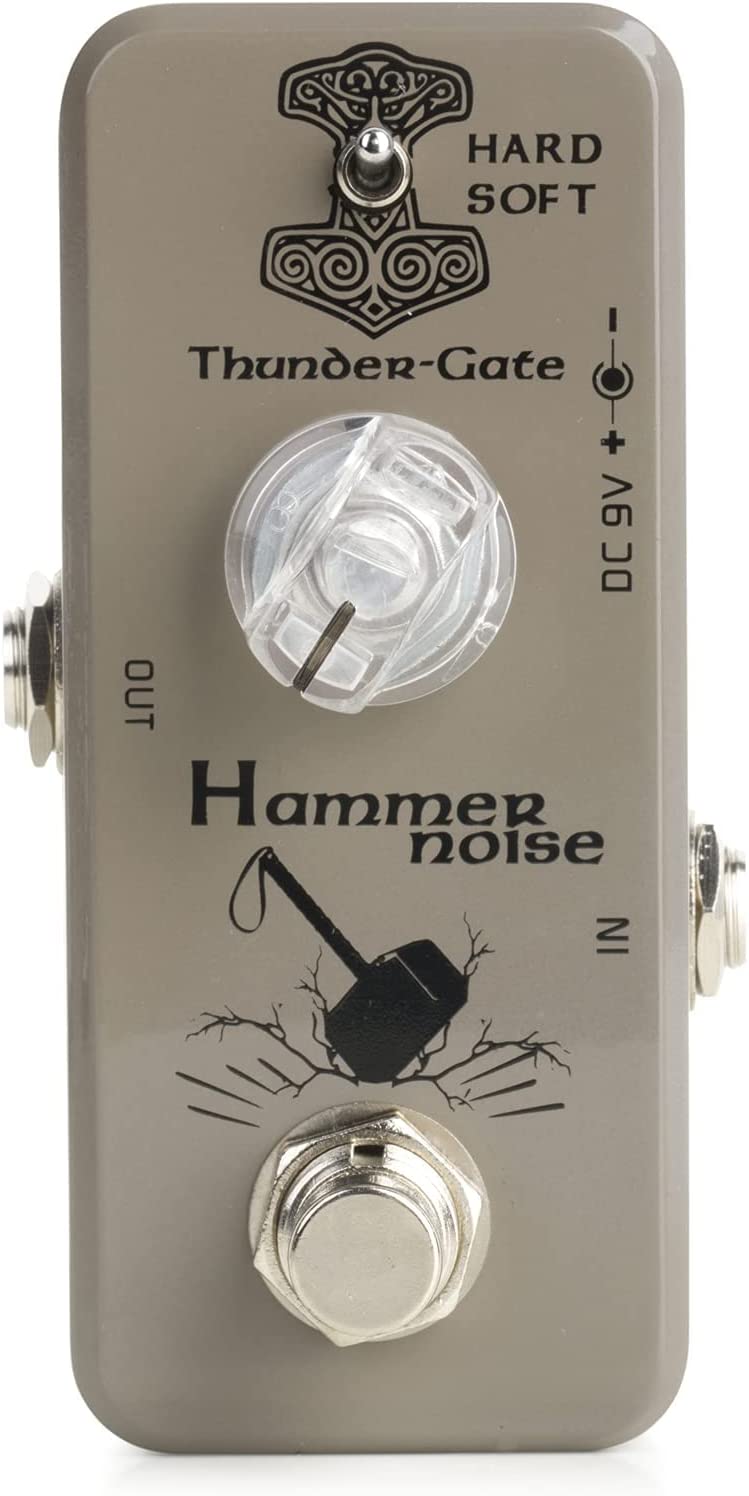
This miniature pedal, the Movall MP-307, is designed to mitigate unwanted noise while preserving the quality of your guitar’s sound.
Housed within a compact and sturdy aluminum alloy casing, it makes an ideal companion for your pedal chain.
Equipped with two modes – ‘Hard’ and ‘Soft’ – it offers flexibility in the noise reduction effect.
The ‘True Bypass‘ design assures an uncompromised signal when not in use, and its LED indicator keeps you informed about its operational status.
Weighing just 0.25 kilograms and powered by a 9V center negative power adapter, which is not included, this pedal is as portable as it is practical.
Whether for an electric guitar, an acoustic one, or a bass, the Movall MP-307 offers efficient noise gate functionality in a small but mighty package.
- My Review
Right out of the gate, it’s clear that the Movall MP-307 Noise Gate Guitar Effect Pedal delivers a considerable punch for its size.
Remarkably small, this pedal is a dynamo designed to tackle pesky, unwanted noise from your guitar’s signal.
Its compact design makes it an easy fit in any pedal chain, and its solid aluminum alloy build feels like it’s made to last.
Sliding the switch between the ‘Hard’ and ‘Soft’ modes, I found a significant degree of flexibility in how it handled noise reduction.
The ‘Hard’ mode gave me an aggressive, hard-hitting cut-off, while the ‘Soft’ mode opted for a more gradual, subtle approach – a versatile choice for different playing styles.
It’s worth noting that this little beast won’t be tamed without its power source.
It requires a 9V center negative power adapter, which is not included, a minor inconvenience.
The LED indicator was nice, offering a clear visual cue on the pedal’s status.
Where this pedal shines is its true bypass design, ensuring your original signal stays as pure as possible when the pedal is not engaged.
On the other hand, I did notice a bit of hiss when the pedal was active.
It wasn’t noticeable while playing, but it made its presence known during quieter moments.
What caught me off guard was its surprising effectiveness with voice echo, a feature not usually associated with noise gate pedals.
Also, while the product is primarily designed for electric and acoustic guitars, I discovered that it also worked wonders with bass.
Here are the ratings I’ll give to the Movall MP-307 Noise Gate Guitar Effect Pedal:
With the Movall MP-307, you get a sturdy, efficient, and versatile noise gate pedal that punches above its weight class.
Its minor flaws are easily overshadowed by its overall performance, offering a considerable bang for your buck.
- Pros:
- Reduces noise in input signal.
- Offers hard and soft noise reduction modes.
- Compact and durable design.
- True bypass with LED indicator.
- Cons:
- Potential for noticeable hiss or noise when active.
- Some units may have quality control issues.
- Not transparent or true bypass in all cases.
My final verdict is that the Movall MP-307 Noise Gate Guitar Effect Pedal offers a decent set of features and performance for its price.
Its ability to reduce noise and convenient size provides a useful tool for guitarists.
However, there are potential downsides, such as noticeable hiss, noise, and quality control issues.
Considering its versatility, features, tone, performance, brand, and value, I would rate this pedal as a solid option for those needing a noise gate effect, earning an overall score of 4 out of 5.
AZOR Noise Gate Pedal
AZOR Noise Gate Pedal reduces noise for improved sound quality with two easy-to-control modes.
AZOR The Noise Killer is a mini guitar effect pedal that reduces the noise from the input signal while keeping the tone intact. It features two noise reduction modes, adjustable threshold knob, LED indicator, and true bypass switch for zero-tone coloration. Easy to use and perfect for creating your own musical tones.
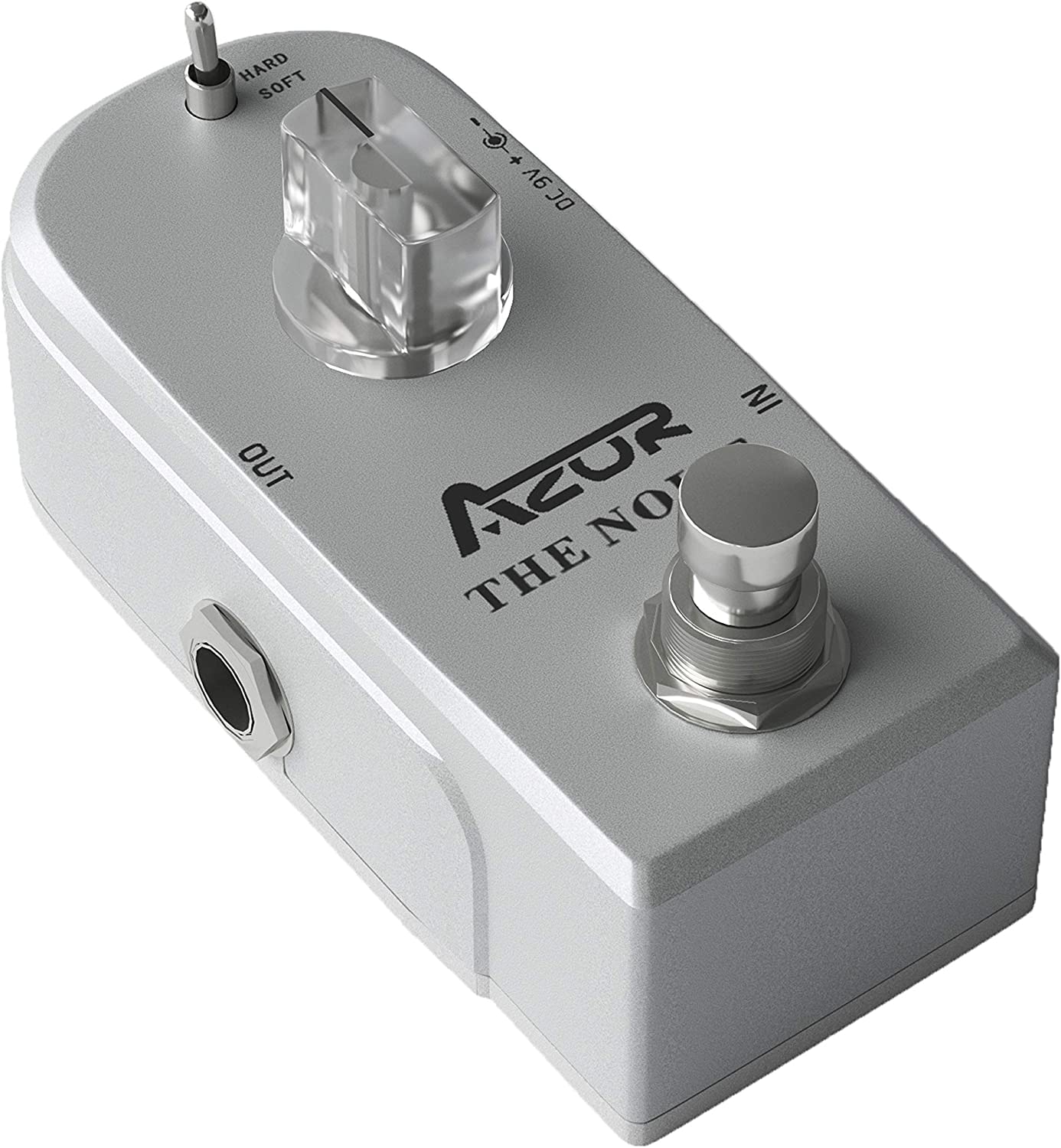
This little dynamo, the AZOR Noise Gate Pedal, is a highly effective sound minimizer for electric guitars and basses.
Its two working modes—Hard and Soft—allow for custom noise reduction, giving musicians control over their sound.
The hard mode offers a more intense noise cut-off, while the soft mode ensures a smoother, less abrupt noise reduction.
Designed with both functionality and portability, it sports a compact and lightweight aluminum alloy chassis.
It’s sturdy and extremely easy to take on the go, perfect for outdoor performances.
The true bypass feature delivers a transparent tone that preserves your instrument’s natural sound.
A handy LED indicator keeps you informed of the pedal’s working status.
Powering it is a breeze with a 9V DC adapter, though you’ll have to purchase it separately as it’s not included.
This mini but mighty device will fit snugly into your music gear setup, a testament to AZOR’s commitment to providing accessible and innovative solutions for musicians.
- My Review
Slipping the AZOR Noise Gate Pedal into my guitar setup was a breeze, and what a compact little marvel it turned out to be!
You won’t be swapping size for substance here; it’s portable and proficient at managing sound levels, a surprisingly versatile asset for any musician.
I immediately found myself drawn to the two modes on offer: Hard and Soft.
Hard mode delivers an impressive punch, curtailing noise efficiently.
However, I found the soft mode to be more of a gentle whisper in its reduction, a subtler approach that I appreciated.
Yet, each mode has its charm and utility, depending on what sound you’re after.
Sturdiness? Check!
Its aluminum alloy frame lends an unexpected heftiness to this lightweight device.
This guy didn’t feel flimsy or unstable; it gave me confidence in its durability.
As someone who values sound purity, I must mention the true bypass feature.
It kept my guitar’s tone transparent and uncolored, a quality that I found particularly valuable.
The device’s LED indicator proved a helpful companion, letting me know its working status at a glance.
And it’s not power-hungry, either.
You’re good to go with just a 9V DC adapter (which you will have to source separately).
There was a small speed bump, however.
I noticed a touch of background hum during my sound trials.
Although not deal-breaking, it might irk some, especially those who cherish sound clarity above all.
It seemed like a minor oversight in a device that excelled in its purpose.
Here are the ratings I’ll give to the AZOR Noise Gate Pedal:
The AZOR Noise Gate Pedal is a reliable, compact tool that delivers what it promises.
It may have a few kinks to iron out, but it certainly goes the extra mile for its price point.
- Pros:
- Easy to control with two working modes.
- Compact and lightweight design.
- True bypass for transparent tone.
- Durable aluminum alloy chassis.
- Cons:
- No power adapter included in the package.
- Some users experienced noise issues.
- Limited diversity in reverb effects.
My final verdict is that the AZOR Noise Gate Pedal offers a compact and lightweight solution for effective noise reduction in guitar and bass setups.
Its two working modes, durable construction, and true bypass feature provide convenience and a transparent tone.
While some users experienced noise issues and the lack of a power adapter may be inconvenient, overall, it delivers good value for the price.
Pigtronix Gatekeeper Micro Noise Gate Pedal
Kill noise without sacrificing tone with the Pigtronix Gatekeeper Micro Noise Gate Pedal.
EMG T System is designed to reduce noise while delivering clear, bright tone for Telecaster guitars. The kit features EMG’s original T Set pickups with Alnico magnets and solderless installation for easy installation.
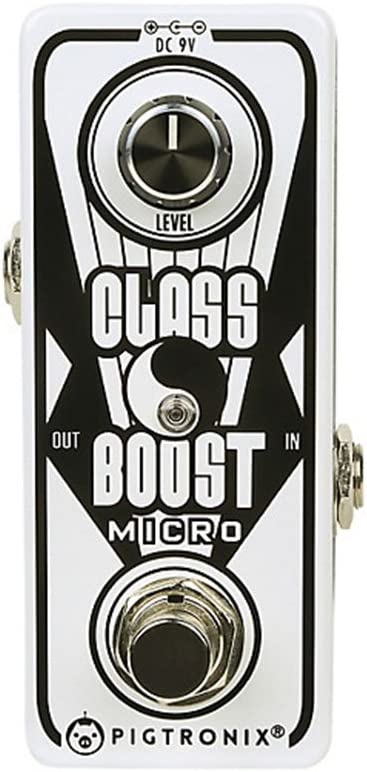
For electric guitar enthusiasts looking to suppress unwanted noise, the Pigtronix Gatekeeper Micro is an ideal companion.
It’s a handy noise gate pedal offering Threshold and Release controls for custom fine-tuning.
This compact device could be a valuable addition to your gear, significantly boosting your signal while maintaining the purity of your guitar’s original tone.
Despite its small size, the Gatekeeper Micro’s performance is commendable, with its ability to effectively cut through any potential signal loss from your board.
It does this without causing any distortion or adding any undesired gravel to the sound.
A quick adjustment can aid in providing that extra oomph for your lead licks or simply enhance your guitar’s output.
Engineered for optimal performance, this little marvel was conceived to keep your tone intact while eliminating unwanted noise, hence living up to its name – Gatekeeper.
Its swift delivery and satisfactory packaging is just the icing on the cake!
- My Review
Jumping into the heart of the matter, I found the Pigtronix Gatekeeper Micro Noise Gate Pedal a remarkable little device that did wonders for my sound.
No more unwanted noise, just my electric guitar’s pure, unadulterated tone.
For such a small gadget, it packs a surprising punch.
Adjusting the Threshold and Release controls was intuitive, providing a customizable experience unique to my playing style.
I noticed an immediate difference.
The Gatekeeper Micro amplified my signal beautifully, bringing my lead licks to life without any hint of distortion or gravel.
That’s what impressed me the most.
What’s more, any potential signal loss on my board was swiftly resolved.
My tone remained true and consistent, even after going through this pedal.
True to its name, the Gatekeeper Micro kept all the noise out, letting only my music through.
And it did so without compromising my tone, which was the cherry on top.
Let’s talk about its prompt delivery and packaging.
It arrived just in time for my gig, neatly packed and ready to rock.
I plugged it in, and it worked like a charm.
There’s something about the simplicity and efficiency of this device that appealed to me.
Maybe it was the fact that it did exactly what it promised to do without any fuss.
Could it be improved? Possibly.
Like any product, there’s always room for improvement.
Here are the ratings I’ll give to the Pigtronix Gatekeeper Micro Noise Gate Pedal:
But as it stands, the Pigtronix Gatekeeper Micro Noise Gate Pedal delivers a performance that’s hard to find fault with.
It’s a reliable, high-quality piece of gear that I would confidently recommend to any guitarist seeking to boost their sound while keeping the noise at bay.
- Pros:
- Boosts signal without adding distortion or gravel.
- Effective for lead licks and signal sweetening.
- Cuts through potential signal loss without distorting.
- Cons:
- Limited control options for threshold and release.
- May not effectively eliminate certain types of noise.
- Relatively higher price compared to similar products.
My final verdict is that the Pigtronix Gatekeeper Micro Noise Gate Pedal appears to be a solid choice for guitarists seeking to eliminate unwanted noise while preserving the tone of their instrument.
It offers notable pros such as signal boosting without distortion, effectiveness for lead licks and sweetening, and cutting through potential signal loss.
However, it’s important to consider the limited control options for threshold and release, the possibility of certain noise types not being effectively eliminated, and the relatively higher price compared to similar products.
Overall, if the features and performance align with your specific needs and budget, this noise gate pedal could be a worthwhile addition to your pedal board.
JOYO Noise Gate Effect Pedal
JOYO Noise Gate True Bypass reduces extra noise for electric guitar pedals with ease.
JF-31 Noise Gate True Bypass pedal is a popular effect from JOYO, providing effective noise reduction and easy setup with adjustable threshold control. The package does not include a power supply or cable, but various bundles are available from the JOYO store.
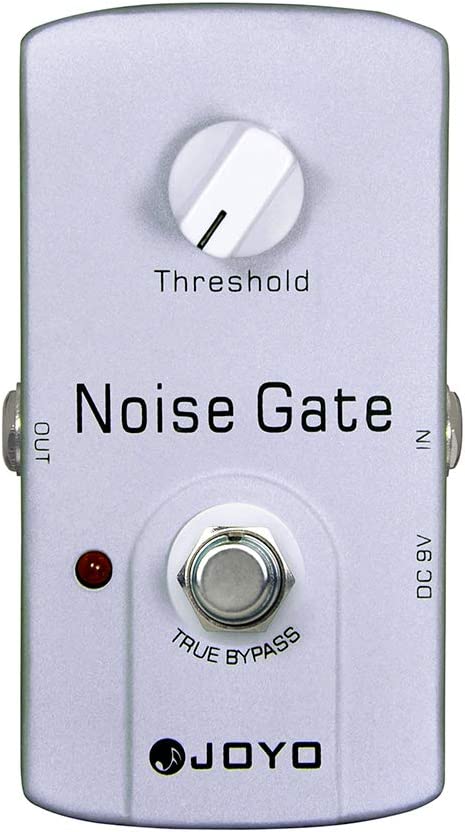
The JOYO JF-31 Noise Gate Effect Pedal is designed to minimize extra noise in your signal chain, making it perfect for electric guitar players.
You can easily control the noise reduction by adjusting the “Threshold” knob.
This pedal features true bypass, ensuring a transparent tone without tone loss.
Crafted with a durable aluminum-alloy housing, this guitar pedal showcases a classic stoving varnish finish, making it stylish and sturdy.
The small LED flash indicator lets you know its working status.
JOYO has a decade-long reputation for producing popular budget pedals, amplifiers, wireless systems, controllers, metronomes, tuners, and inspiring musicians worldwide.
Ensure your guitar is fully connected to use the JOYO Noise Gate pedal properly.
To prevent unexpected noise and ensure optimal performance, it is recommended to use an additional JOYO original power adapter or a reliable brand that meets the current working requirement of the pedal.
This product is lightweight, weighing only 200 grams, and has dimensions of 4.65 x 1.97 x 2.68 inches.
- My Review
As an experienced reviewer, I recently had the opportunity to try out the JOYO JF-31 Noise Gate Effect Pedal for electric guitar, and I have to say, it lives up to its reputation.
One of the biggest challenges any guitar player faces is dealing with unwanted noise in their signal chain, and this pedal tackles that issue quite effectively.
Adjusting the noise reduction level was incredibly simple, thanks to the single “Threshold” knob.
Moreover, the pedal features a true bypass, which allows for a crystal-clear and transparent tone without any loss in quality.
I appreciated the attention to detail in its design, from the durable aluminum-alloy housing to the classic stoving varnish finish.
The small LED flash indicator also provided a useful visual cue for the pedal’s working status.
In my experience, JOYO has always been synonymous with quality and affordability, and the JF-31 Noise Gate is no exception.
I would recommend investing in a separate JOYO original power adapter to ensure optimal performance and avoid unwanted noise.
On the downside, I did find that the pedal might not be the perfect fit for every musician’s needs, especially those seeking a very specific type of noise reduction.
It’s important to remember that this is a budget pedal, so some compromise on performance is to be expected.
The pedal may not be ideal for high-gain settings where tight rhythm work is required, but it certainly delivers in many other areas for the price point.
Here are the ratings I’ll give to the JOYO Noise Gate Effect Pedal:
From my experience with this pedal, I can confidently say that it offers solid performance, exceptional build quality, and an attractive design, all at an unbeatable price.
Although it may not be the perfect noise gate for every guitarist, the JOYO JF-31 Noise Gate Effect Pedal is worth considering for those seeking a reliable, budget-friendly option in their quest for a cleaner signal.
- Pros:
- Effective noise reduction.
- True bypass for clear tone.
- Durable and stylish design.
- Cons:
- Not ideal for high-gain settings.
- Limited noise reduction options.
- Requires separate power adapter.
My final verdict is that the JOYO JF-31 Noise Gate Effect Pedal is a solid, budget-friendly option for guitar players seeking effective noise reduction and a high-quality build.
However, it may not be the best choice for those dealing with more complex noise issues or requiring more versatility in high-gain settings.
Jim Dunlop Dyna Comp Guitar Effects Pedal
Smooth sustain and percussive click with Jim Dunlop’s Dyna Comp.
The MXR Dyna Comp is a classic compressor pedal, providing percussive click sound on clean guitars and smooth sustain on lead lines. It is powered by either a Dunlop ECB003 AC adapter or a single 9 volt battery.
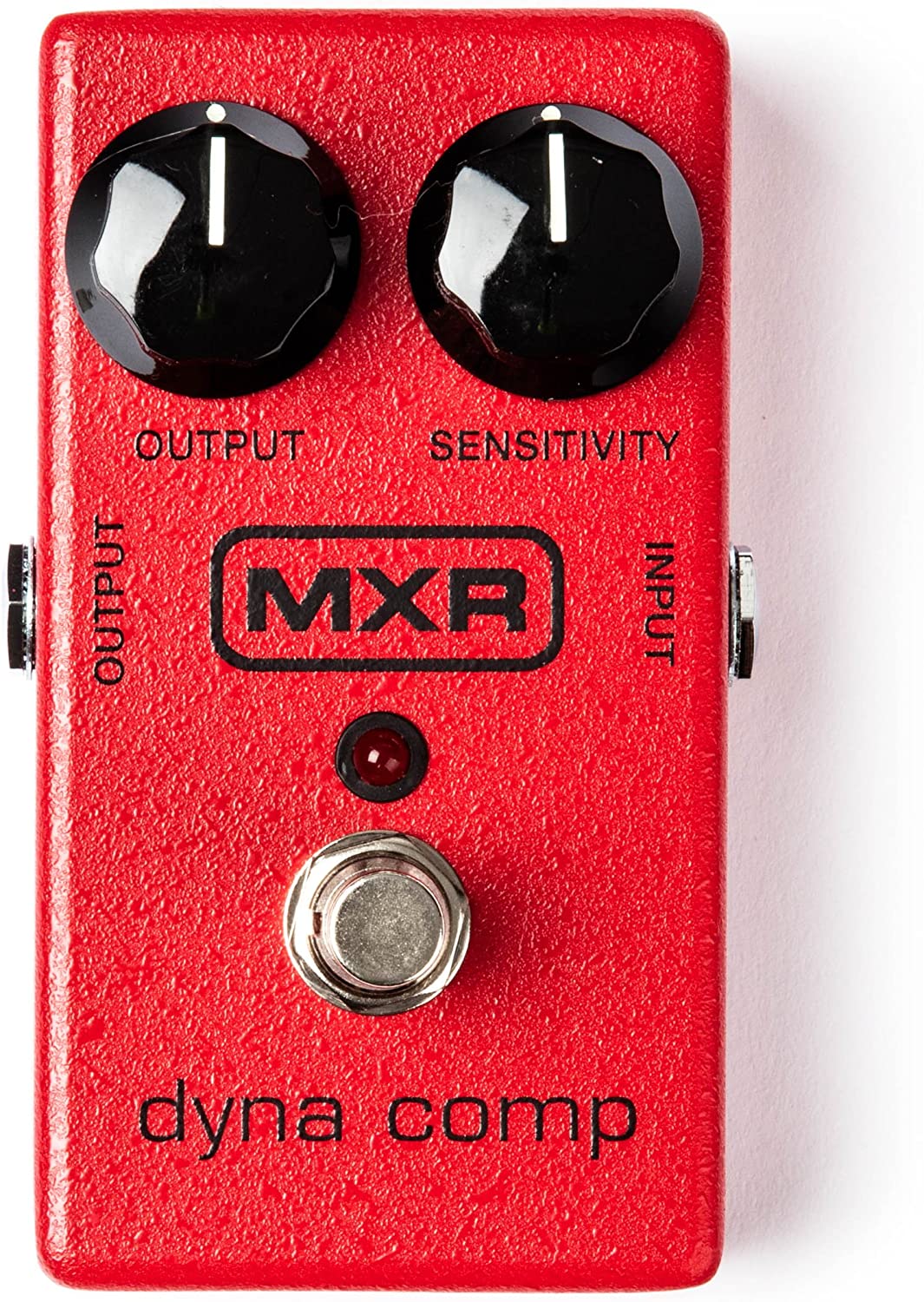
The Jim Dunlop Dyna Comp Guitar Effects Pedal is a well-regarded in-line compressor that balances the signal to your amplifier.
This helps create increased sustain with more stable dynamics, making it a standard piece of equipment in Nashville studios.
A Dunlop ECB003 AC Adapter or a single 9-volt battery can power the pedal.
It features a constant output signal, a compression circuit, and a sensitivity control to adjust the effect according to your preferences.
With impressive tone quality, the Jim Dunlop Dyna Comp has a model number M102.
JIM DUNLOP, a New York-based manufacturer, produced this multicolored compressor pedal, and initially founded MXR Innovations in 1974.
The company continues manufacturing the original effects units while adding new products.
The pedal has dimensions of 5.8 x 4.5 x 2.8 inches and weighs 1.05 pounds, making it a durable and portable addition to any guitarist’s setup.
- My Review
Upon trying out the Jim Dunlop Dyna Comp Guitar Effects Pedal, I was impressed by its ability to balance and even out my guitar signal.
As I experimented with the sensitivity control, I found that it helped create desirable sustain and stable dynamics, which is why it’s a popular choice among Nashville studio musicians.
The design and build quality of the pedal exceeded my expectations – the sturdy metal construction assured me that it could withstand regular use during gigs and practices.
The multicolored design also adds a nice visual touch to my pedalboard.
Powering the pedal was a breeze, as it offered the option of using a Dunlop ECB003 AC Adapter or a simple 9-volt battery.
The constant output signal and compression circuit contributed to the superb tone I could achieve.
It’s important to note, however, that while the Dyna Comp excels in many areas, it does have its drawbacks.
For instance, it can be quite noisy, which may concern some players.
Ensuring a clean setup with quality cables and a noise suppressor could help mitigate this issue.
Additionally, while this pedal works wonders with single-coil pickups, its impact on humbucker-equipped guitars may be less noticeable.
You’ll want to consider this if you mainly play guitars with humbuckers.
Here are the ratings I’ll give to the Jim Dunlop Dyna Comp Guitar Effects Pedal:
Another aspect I noticed was that the pedal tends to color the sound coming from your guitar.
This may be a drawback for some, while others may see it as a unique feature that adds character to their tone.
- Pros:
- Great signal balance and sustain.
- Sturdy metal construction.
- Versatile sensitivity control.
- Cons:
- Can be quite noisy.
- Less impact on humbuckers.
- Colors original guitar tone.
My final verdict is that the Jim Dunlop Dyna Comp Guitar Effects Pedal is a reliable and valuable addition to any guitarist’s setup, with its impressive balance, sustain, and sturdy construction.
Despite a few minor drawbacks, its overall performance and features make it a worthy investment for those seeking to enhance their tone and playing experience.
ISP Technologies Decimator II Noise Reduction Pedal
Smooth, transparent noise reduction with innovative tracking.
ISP Technologies’ Decimator II Noise Reduction Pedal offers improved smoothness and transparency, featuring two pending patents and linearized Time Vector Processing for superior tracking. Connecting two pedals between your guitar and amp allows direct tracking of your instrument signal.
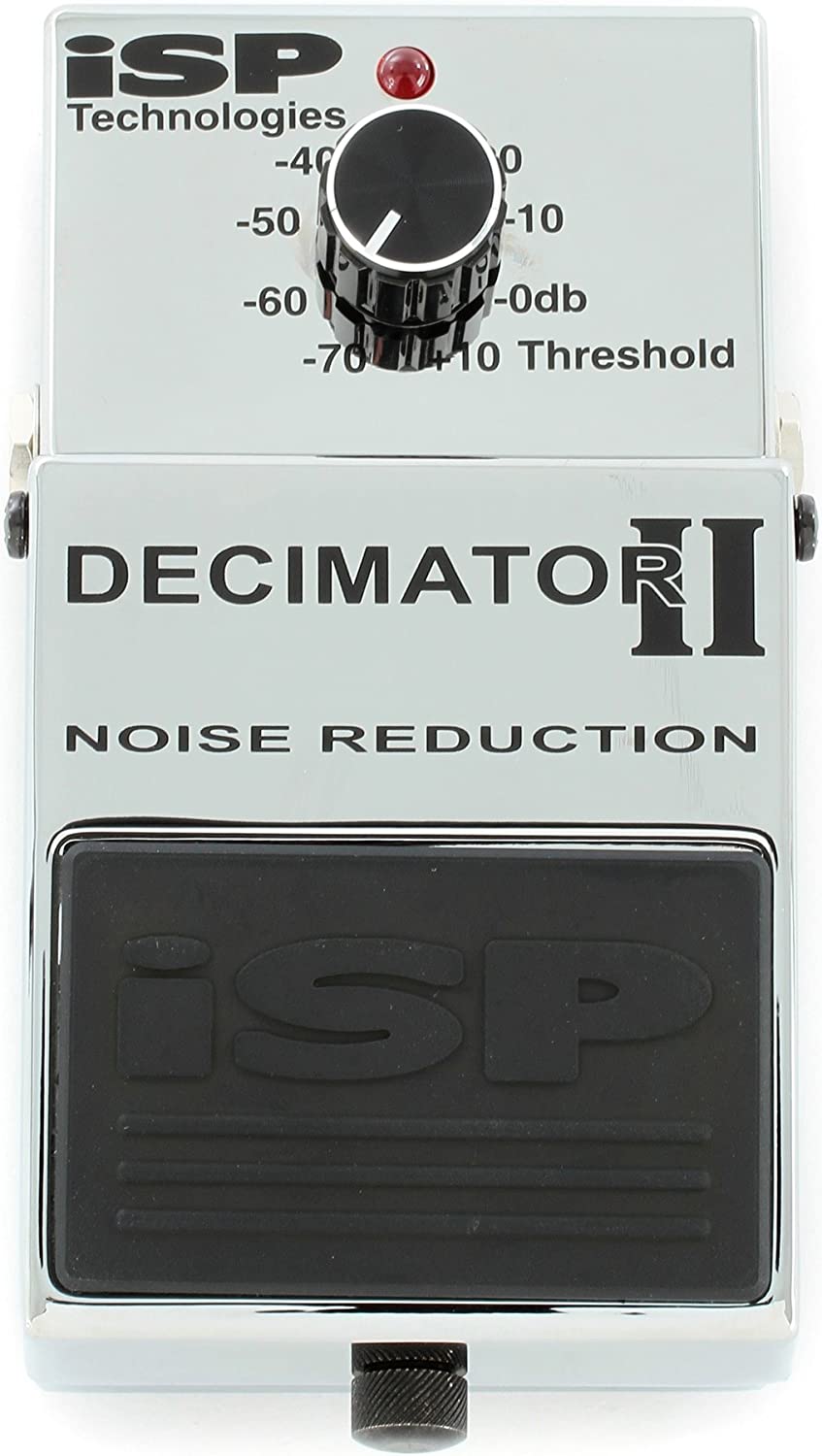
The ISP Technologies Decimator II Noise Reduction Pedal is an enhanced version of the original Decimator, designed to help guitarists minimize noise levels in their audio setup.
This compact device offers upgraded performance, boasting a smoother release response and a nearly transparent noise reduction experience, making note decay feel incredibly natural.
The Decimator II employs advanced linearized Time Vector Processing to ensure improved expander tracking, making it highly effective at isolating and reducing noise in your audio signal.
By placing this pedal between your guitar and your amplifier and connecting a second one in the effects loop, you can achieve an incredible tracking performance similar to the popular ProRack G system.
Weighing only 1.66 lbs and requiring 9 volts to operate, this transparent-colored pedal from ISP Technologies is highly functional but also portable and user-friendly for guitarists looking to eliminate unwanted noise while preserving their instrument’s sound quality.
- My Review
I recently had the chance to try out the ISP Technologies Decimator II Noise Reduction Pedal, and it lived up to its promises.
When I first plugged this pedal into my setup, I noticed it was as if the unwanted noise was wiped away, leaving me with a clean, articulate sound that still maintained my guitar’s natural character and warmth.
During my time with Decimator II, I found the improved smoothness of the release response to be quite impressive.
It seemed to eliminate almost all release ripples, allowing the notes to decay naturally without any unwanted interruptions.
The advanced linearized Time Vector Processing also contributed to the pedal’s enhanced tracking performance, isolating and reducing noise in the audio signal without sacrificing the overall signal quality.
Be cautious not to “over-reduce” your signal, as it could clip the desired sound.
But with some experimentation and finding the sweet spot, this pedal can do wonders for your audio setup.
Portability was another standout feature of this noise-reduction pedal.
Its compact size and lightweight body made it easy to transport and set up.
I appreciated the straightforward design and the transparent color, as they provided a sleek and professional appearance while integrating seamlessly into my pedalboard.
However, I did come across a slight issue with a white noise static sound appearing between notes, even when the strings were muted.
While this may not be a deal-breaker for some, it’s worth noting if you’re particularly sensitive to noise or working within a highly professional recording environment.
Here are the ratings I’ll give to the ISP Technologies Decimator II Noise Reduction Pedal:
In my experience, the ISP Technologies Decimator II Noise Reduction Pedal was a valuable addition to my gear, effectively mitigating noise and allowing me to focus on my performance.
With its portable design and high-quality performance, I wouldn’t hesitate to recommend this pedal to fellow musicians looking to enhance their sound and eliminate unwanted noise from their setup.
- Pros:
- Effective noise reduction.
- Smooth release response.
- Compact and portable.
- Cons:
- White noise issue between notes.
- Potential signal clipping.
- Requires careful adjustment.
My final verdict is that the ISP Technologies Decimator II Noise Reduction Pedal is a valuable and effective addition to any guitarist’s pedalboard.
While it has a few minor issues that might require careful adjustments, its overall performance, features, and value make it a worthwhile investment for those looking to improve their audio quality and minimize unwanted noise.
Stax Guitar Noise Gate Pedal
Stax Noise Gate Pedal offers noise reduction, true bypass, and solid construction.
The Stax Noice Gate Pedal reduces noise while preserving your original signal clarity. Made of durable zinc alloy, it features true bypass and LED indicator for easy operation. Comes with power supply, manual, and packing box.
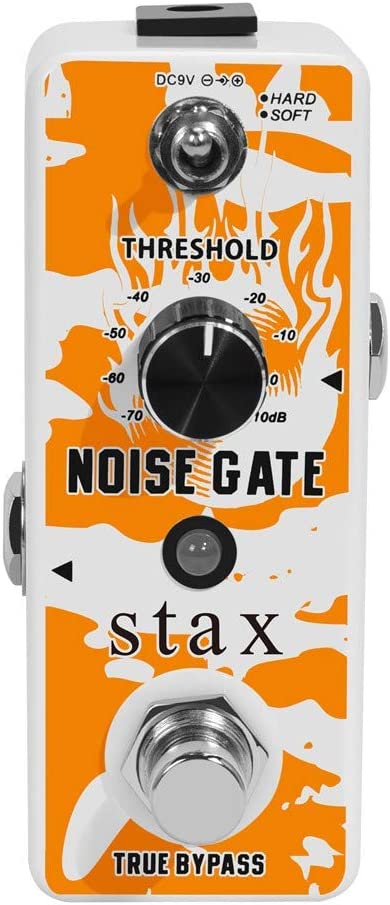
Imagine you’re jamming out on your guitar with the power of the Stax Guitar Noise Gate Pedal under your foot.
This device, a vital addition to your effects setup, can alter your playing experience remarkably.
It’s an impressive piece of technology designed to keep any unwanted noise at bay, ensuring the purity of your tone throughout your performance.
You’ll find that this pedal provides a practical and efficient solution to handle any electrical hum or string buzz that might creep into your sound.
It’s equipped with an adjustable threshold control that gives you complete power over how much noise gets eliminated.
More than just a noise reducer, it also includes a decay control feature that allows you to determine the speed at which the gate closes after the signal drops below the set threshold.
It’s a versatile pedal, built to handle the demands of any style and designed for intuitive operation.
The Stax Guitar Noise Gate Pedal can undoubtedly bring a new level of precision and clarity to your guitar-playing experience.
- My Review
After spending some time with the Stax Guitar Noise Gate Pedal, I’ve found it indispensable in maintaining a clean, clear guitar sound.
Packed with features, it goes beyond the basic role of noise reduction to offer more nuanced control over your playing.
One of the standout features of this pedal is the adjustable threshold control.
I found it extremely helpful in tailoring the pedal’s noise reduction to match the specifics of my setup.
I could fine-tune it to deal effectively with hum, buzz, and other unwanted noise while preserving the nuances of my guitar’s tone.
Then there’s the decay control.
The ability to dictate how quickly the gate closes after the signal drops below the set threshold made a world of difference to my playing.
It allowed me to create subtle sound variations and control the pedal’s response to my playing dynamics.
As for its build quality, the pedal felt sturdy under my foot, and the controls were smooth and responsive.
It appeared to be well-constructed, promising good reliability in the long run.
However, the pedal is not without its flaws.
While it is excellent at managing unwanted noise, the implementation could be more transparent.
I noticed some coloration in the tone, particularly when the threshold was set high.
This may not bother all players, but it might be a consideration for those who demand absolute tonal transparency.
Despite this, the Stax Guitar Noise Gate Pedal is a powerful ally in the quest for a cleaner, clearer guitar sound.
Here are the ratings I’ll give to the Stax Guitar Noise Gate Pedal:
It combines robust noise reduction with detailed control options in a sturdy and user-friendly package.
It certainly earned its place on my pedalboard.
- Pros:
- Reduces noise without lowering signal quality.
- Offers hard and soft modes of noise reduction.
- Constructed with durable zinc alloy material.
- True bypass for transparent tone.
- Compact size saves space on pedal board.
- Cons:
- Some reviewers experienced latency issues.
- Latency may affect specific uses, like pitch shifting.
- A few reviewers reported quality or functionality issues.
My final verdict is that the Stax Guitar Noise Gate Pedal offers decent features and good price value.
While it may have some latency issues and a few reported quality concerns, it receives positive reviewer feedback.
The pedal’s compact size, noise reduction capabilities, and true bypass feature make it a practical choice for guitarists looking to reduce unwanted noise without compromising their original signal.
However, its versatility and tone might not meet the expectations of more advanced or specific use cases.
Considering its brand reputation and positive customer experiences, the Stax Guitar Noise Gate Pedal is a solid option for those seeking an affordable noise gate solution.
MXR M235FC Smart Gate Pedal
Easily switch and sync dual channels with genuine Dunlop foot switcher.
M235 Smart Gate Pro Pedal offers powerful and precise noise control for guitar and bass rigs, with two knobs for controlling threshold and release time, plus a low-cut filter and bypass switch. Perfect for both studio and live settings.
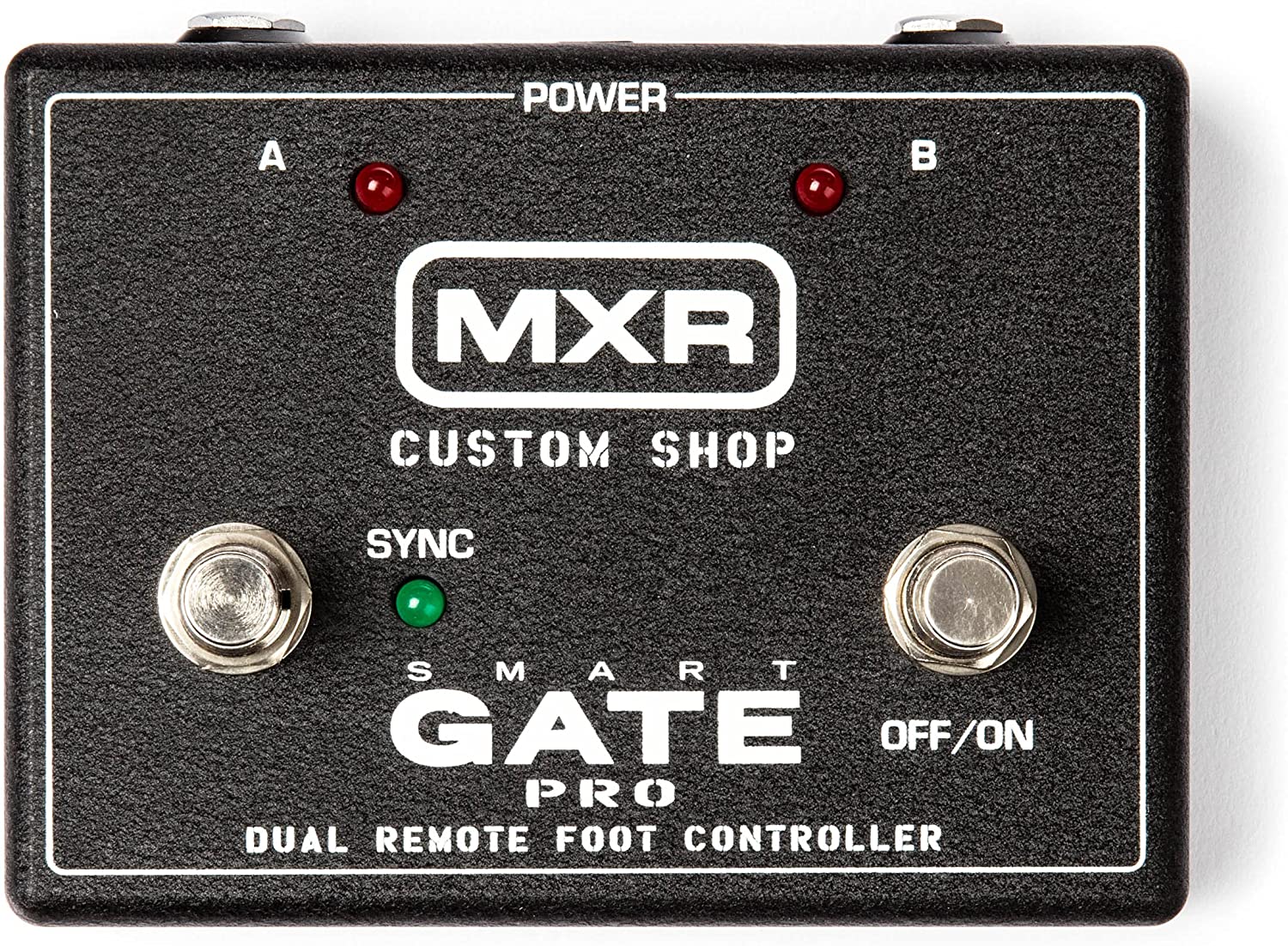
The MXR M235FC Smart Gate, Pro Foot Controller, is a companion pedal that pairs with the M235 Smart Gate Pro Rack Module.
Its unique dual-channel design provides an exceptional level of versatility.
You can seamlessly switch between channels one and two or synchronize them if desired.
It’s essentially a tool to tailor your sound according to your needs.
The fact that it’s a genuine Dunlop foot switcher only adds to its reliability and functionality.
This nifty device extends your control options and allows you to manage your rack module from a distance, offering a whole new level of convenience.
It is a testament to MXR’s dedication to providing musicians with high-quality, practical solutions.
- My Review
After experimenting with the MXR M235FC Smart Gate Pro Foot Controller, it offers much more than initially suggested.
First off, I was immediately drawn to its dual-channel remote function.
I could swiftly transition between channels one and two, adding an extra dimension to my performance, both in a live setting and while I was practicing at home.
Digging deeper, I noticed its compatibility with the M235 Smart Gate Pro Rack Module.
This pairing isn’t just a clever marketing tactic; it elevates your control and precision when sculpting your sound.
Syncing both channels was a breeze, providing a unique blend of tones I’d never thought I’d achieve.
Yet, I can’t avoid mentioning one notable aspect that didn’t sit quite right with me.
In the heat of a live performance, swift and accurate switching is essential.
Despite the smooth transitions this pedal provides, I found the physical design could do with a little refinement for more reliable contact during high-pressure moments.
With that said, this device is unmistakably a genuine Dunlop foot switcher.
If one thing resonates with me, it’s the consistent quality and reliability that Dunlop brings to the table.
This foot controller didn’t disappoint in this regard.
It’s sturdily built and reliable, sure to withstand the rigors of regular use.
Another thing that stands out is how this foot controller offers a new perspective on convenience.
Whether on stage or in the studio, the MXR M235FC Smart Gate Pro Foot Controller allows you to manage your sound from afar.
For me, this function was the icing on the cake.
Here are the ratings I’ll give to the MXR M235FC Smart Gate Pedal:
Despite a minor hiccup, this foot controller left a positive impression on me.
It’s a testament to MXR’s commitment to creating useful, practical, and high-quality equipment for musicians.
- Pros:
- Dual channel remote foot controller.
- Easy switching between channels 1 & 2.
- Genuine Dunlop foot switcher.
- Cons:
- Limited compatibility with certain setups.
- Relatively high price compared to similar products.
- May require additional power supply or cables.
My final verdict is that the MXR M235FC Smart Gate® Pro Foot Controller is an excellent choice for musicians seeking a versatile and feature-packed foot controller.
With its dual-channel remote control, easy switching capabilities, and the reliability of the Genuine Dunlop foot switcher, this product offers convenience and performance.
The overall brand reputation of MXR adds to its appeal.
While the price may be relatively higher compared to similar products, the value provided by its functionality and quality justifies the investment.
Therefore, I highly recommend the MXR M235FC Smart Gate® Pro Foot Controller to enhance their pedalboard setup and achieve superior tone control.
What exactly is a noise gate pedal?
A noise gate pedal, in its most fundamental essence, is a type of guitar effect pedal designed to control the level of noise or unwanted signal that occurs when not playing your instrument.
When you think about music, particularly the electric guitar, it’s easy to be drawn into the rich sounds, power chords, ripping solos, and rhythmic strums.
But underlying all this glory is an inherent feature of electric guitars and their amplifiers – they can produce much background noise.
The purpose of the noise gate pedal is to minimize unwanted noise, especially when you’re not playing the guitar.
You can consider it a sort of gatekeeper; it lets through the sounds you want and blocks out those you don’t.

This effect is achieved by setting a certain threshold level, the signal at which the gate opens, to allow sound through.
When the signal falls below this threshold, the gate closes, cutting off the sound and reducing the noise.
Therefore, it’s termed a “gate” because it opens and closes based on the level of the input signal.
The noises usually come from various sources, including the hum of an amplifier, interference from lights or electronic devices, or the natural hum and buzz that can come from electric guitars themselves.
This is particularly true when using effects like distortion or overdrive, which can significantly amplify the noise.
Therefore, if you enjoy high-gain tones or have a complex pedalboard setup, a noise gate pedal can be a vital addition to your rig.
There are different types of noise gates, and they operate on the same basic principle but may offer different features.
Some noise gates are simple and have only a threshold control, which you set based on your guitar’s output level.
Others might offer more adjustable parameters such as attack, decay, or hold settings.
The attack determines how quickly the gate opens when the signal exceeds the threshold, the hold keeps the gate open for a set time after the signal drops below the threshold, and the decay determines how quickly the gate closes after the hold time has elapsed.
It’s also noteworthy to mention that, like all effects, a noise gate must be balanced.
Set the threshold too high, and the gate may cut off your guitar’s sustain or make your playing sound choppy because it cuts off sounds you want to come through.
It’s important to note that noise gate pedals don’t eliminate the noise source; they merely suppress the noise when you’re not playing.
Set it too low, which may not effectively reduce unwanted noise.
It’s this delicate balance that must be negotiated with the use of a noise gate.
Your playing style, the other effects, and your tolerance for noise versus a natural guitar sound will all play into your ideal noise gate settings.
Noise gate pedals come in all shapes and sizes and from various manufacturers.
Some popular options include the Boss NS-2 Noise Suppressor, the Electro-Harmonix The Silencer, and the TC Electronic Sentry Noise Gate.
These models and many others provide different features to help customize your sound and noise control needs.
What should you consider when choosing a noise gate pedal?
We’ll discuss the crucial considerations when choosing a noise gate pedal to ensure you invest in the right tool for your setup, maximize noise reduction, and maintain your instrument’s natural tone.
– Threshold and range:
One of the most critical factors to consider when choosing a noise gate pedal is the adjustable threshold and range options.
The threshold determines the level at which the pedal starts eliminating or reducing background noise, and the range establishes the level of noise reduction applied when the signal drops below the threshold.
A wide range of threshold and range settings is essential, as it allows you to fine-tune the noise gate to suit your unique playing style and preferences.
This customization ensures that the pedal will work effectively in different environments or when using different instruments or amplifiers.
A quality noise gate pedal should offer a good balance between simplicity and versatility, enabling users to quickly and easily achieve the desired level of noise reduction without compromising the overall performance or sound quality.
– Attack and release times:
Attack and release times are also crucial when choosing a noise gate pedal.
The attack time refers to how quickly the noise gate takes effect once the input signal drops below the threshold, while the release time dictates how long the gate remains open, allowing the note to decay naturally.
Adjustable attack and release times provide greater control over the pedal’s performance and ensure that it can be tailored to various playing scenarios.
Different music genres and playing techniques may require distinct attack and release settings, so having a noise gate pedal with adjustable parameters will accommodate these varying needs.
Look for a pedal that allows for easy customization of these settings to achieve optimal results in reducing unwanted noise while maintaining the dynamics and expressiveness of your playing.
– Quality and transparency:
A noise gate pedal’s sound quality and transparency must not be overlooked.
High-quality pedals should not compromise your instrument’s tone when engaged; that means the pedal should be transparent and not alter the natural sound of your guitar or bass.
Choose a noise gate pedal designed with transparency in mind, ensuring that your tone remains unchanged when the pedal is active.
The best pedals in this category will reduce noise while maintaining your instrument’s original tonal characteristics, preserving its warmth, dynamics, and expressiveness.
– True bypass:
Another important factor to consider when choosing a noise gate pedal is whether or not it features a true bypass.
A true bypass pedal will not affect your instrument’s signal when it’s not in use, whereas a non-true bypass pedal can potentially color or degrade your tone even when the effect is turned off.

True-bypass noise gate pedals are ideal, as they ensure that your signal path remains clean and unaffected when the pedal is disengaged, preserving the integrity of your instrument’s natural tone.
This feature is especially important in more extensive signal chains where multiple pedals have the potential to impact your instrument’s sound negatively.
– Ease of use and user interface:
No matter how feature-rich a pedal may be, it can quickly become frustrating if it’s challenging to use.
The ideal noise gate pedal must be user-friendly, with a clear, intuitive interface that enables users to navigate the pedal’s settings easily.
Look for a noise gate pedal with easy-to-understand controls and functions that allow you to play more and less time fiddling with settings.
Some noise gate pedals may also include LED indicators to show how the gating effect is applied, making it easier to fine-tune settings in real time.
– Brand reputation:
When choosing a noise gate pedal, considering the reputation of the brand or manufacturer can be valuable.
Some brands are well-known for producing high-quality, reliable, and long-lasting pedals, which can help ensure you make a wise investment in your gear.

Research the brand’s history and track record in the industry, and look for those that have consistently delivered quality products with a strong customer satisfaction rating.
A well-established and reputable brand will likely offer a reliable noise gate pedal backed by good customer support and potential warranty options.
– Price and budget:
As with any gear purchase, price, and budget constraints will affect your decision-making process.
Noise gate pedals come in a wide range of prices, from highly affordable options to more expensive, feature-rich models.
Establishing a budget that works for you and assessing the available options within that budget range is essential.
While opting for a cheaper pedal may be tempting, remember that the lowest-priced options might not provide the best performance or durability.
Consider investing more in a quality pedal that meets your needs and offers a better overall experience.
– Reviews and recommendations:
Finally, don’t forget to carefully read reviews and seek recommendations from fellow musicians when choosing a noise gate pedal.
Personal experiences from other musicians can provide valuable insight into a pedal’s performance, features, and potential drawbacks.
Make sure to read reviews from reputable sources such as music publications, online forums, and retailers, and consider seeking the advice of musicians who play a similar style or use similar gear.
This information will help you make a better-informed decision when investing in a noise gate pedal, ensuring you find the perfect pedal for your unique needs and preferences.
How to properly use a noise gate pedal?
Unlocking the full potential of a noise gate pedal requires understanding its controls, careful placement in your signal chain, and fine-tuning settings to match your playing style.
We’ll walk you through the essential steps to properly use a noise gate pedal, eliminate unwanted noise, and preserve the quality of your instrument’s tone and dynamics.
– Understand the pedal’s controls
To properly use a noise gate pedal, it’s essential to begin by familiarizing yourself with each control and its function.
This understanding will help you make informed decisions when setting up the pedal and adjusting it to your preferences.
Common controls on a noise gate pedal include the threshold, range, attack, release, and any additional settings unique to the specific pedal.
The threshold control determines the level at which the pedal eliminates or reduces background noise.
Lowering the threshold will make the noise gate activate more quickly, cutting off quieter sounds, whereas raising the threshold will enable more quiet sounds to pass through, potentially allowing some noise to come through too.
The range control dictates the amount of noise reduction when the input signal drops below the threshold.
A higher range setting provides more aggressive noise reduction, while a lower range setting results in a more subtle and nuanced reduction.
Attack and release times control how quickly the noise gate takes effect and lets the note decay naturally.
These controls are crucial in preserving the original dynamics and expressiveness of your playing while reducing unwanted noise.
Refer to the pedal’s manual for a more detailed explanation of each control and its function.
Understanding these controls will help you properly set up the pedal for optimal performance.
– Set up your signal chain
The placement of the noise gate pedal in your signal chain plays a critical role in its effectiveness.
It is generally recommended that you place the noise gate pedal early in the signal chain before any gain or distortion pedals.
This placement allows the pedal to process the clean, unaltered guitar signal, minimizing interference from other effects and reducing the chances of negative effects on your tone.
However, it’s essential to experiment with different placements in your signal chain to find the optimal position for your unique setup.
For example, if using a compressor pedal, try placing the noise gate before and after the compressor and compare the results.
Adjusting the order of your pedals in the signal chain can considerably impact the overall sound, so spend time experimenting and finding the best arrangement for your needs.
– Set the threshold
Once the noise gate pedal is in the signal chain, it’s time to begin setting the controls.
Start with the threshold control, the crucial parameter to initiate the gate effect.
Setting the threshold to a middle position serves as a good starting point.
Play your instrument with your desired picking or strumming intensity and gently adjust the threshold, increasing or decreasing the level to the point where the noise gate suppresses unwanted noise without cutting off quiet passages or the tail end of sustained notes.
Be aware that overly aggressive threshold settings can result in unwanted artifacts or choppy sounds in your playing.
– Adjust the range
After setting the threshold, it’s time to focus on the range control, which determines the amount of noise reduction when the volume drops below the threshold.
Start by setting the range to a moderate level and fine-tuning it according to your needs and preferences.
Pay attention to how your instrument sounds when the noise gate kicks in.
Adjust the range to a point that effectively reduces noise but doesn’t make unwanted alterations to your tone.
In some cases, a lower range may result in a more musical gating effect that preserves the nuances and expression of your performance.
In contrast, a high range may create a more abrupt and noticeable gating effect.
– Set the attack and release times
To optimize the performance of your noise gate pedal, spend time adjusting the attack and release times.
The attack time determines how quickly the noise gate takes effect when the input signal drops below the threshold.
At the same time, the release setting controls how long the gate remains open, allowing the note to decay naturally.

Start with moderate attack and release settings and play your instrument through the pedal, paying close attention to how quickly the noise gate opens after triggering and how smoothly the note decays when the gate closes.
Experiment with different attack and release settings to find the perfect balance that maintains the natural dynamics of your playing and preserves your intended musical expression.
– Test and fine-tune the settings
After setting up the noise gate pedal and adjusting the threshold, range, attack, and release times, testing the pedal in various playing situations is vital and tweak the settings as needed.
Play your instrument through the pedal and evaluate how effectively the noise gate removes unwanted noise while preserving the original tone, sustain, and dynamics.
As with any gear, fine-tuning the settings to fit your style and preferences is key to getting the most out of your noise gate pedal.
Don’t be afraid to make minor adjustments to the threshold, range, attack, and release times as you play.
Try different techniques, such as palm muting or fingerpicking, and evaluate how the pedal responds to these dynamic changes.
– Experiment and adapt
Properly using a noise gate pedal often involves trial and error, experimentation, and adaptation.
Each musical situation, playing style, and instrument may require different settings or adjustments to the pedal’s controls.
Be open to trying different combinations of threshold, range, attack, and release settings to find the ideal noise reduction without compromising the natural tone and dynamics of your playing.
Also, remain prepared to adjust the settings in different live or recording situations, as the acoustics and equipment involved may affect how the noise gate functions.
By continuously adapting and experimenting, you will unlock the full potential of your noise gate pedal and enhance your overall sound quality.
How to order pedals on a pedalboard?
There is no one-size-fits-all approach to ordering pedals on a pedalboard, as the optimal arrangement largely depends on the specific sound you’re aiming for.
Usually, though, you will see guitar players mostly agreeing with this order:
Tuner > Filters/Dynamics > Pitch-based Effects > Overdrive/Distortion > Modulation > Time-based Effects > Looper
Aside from that, some general guidelines can help you achieve a balanced and versatile setup.
Let’s talk in detail about the order we just mentioned, but feel free to experiment and adjust to your own preferences:
- Tuner: Place your tuner pedal first to ensure your signal is in tune before passing through the other pedals.
- Filters and dynamics: Wah-wah, envelope filters, compressors, EQs, and noise gates should come next. These pedals affect your sound’s dynamic and tonal aspects, so it’s best to place them early in the chain.
- Pitch-based effects: Octavers, harmonizers, and pitch shifters should come after filters and dynamics since these pedals alter the pitch of your signal and work best with a clean, unprocessed sound.
- Overdrive and distortion: Overdrive, distortion, and fuzz pedals typically come next. They shape your guitar’s core sound, and placing them before most other effects ensures that those effects receive a strong, consistent signal.
- Modulation effects: Chorus, flanger, phaser, and tremolo pedals should be placed after overdrive and distortion effects. We do this to allow these pedals to add depth and movement to your sound without becoming overly distorted or overbearing.
- Time-based effects: Delay and reverb pedals should be placed towards the end of your signal chain. This allows them to create a sense of space and depth around the other effects, simulating the sound of a room or hall.
- Looper: If you use a looper pedal, it should be placed last in the chain. This ensures that you’re looping the entire signal, including all the effects you’ve applied.
Remember, these are just general guidelines and what generally works and sounds good.
The most important thing is to experiment and find the arrangement that best suits your personal sound and style.
For example, here’s one pedalboard signal chain that I always use:
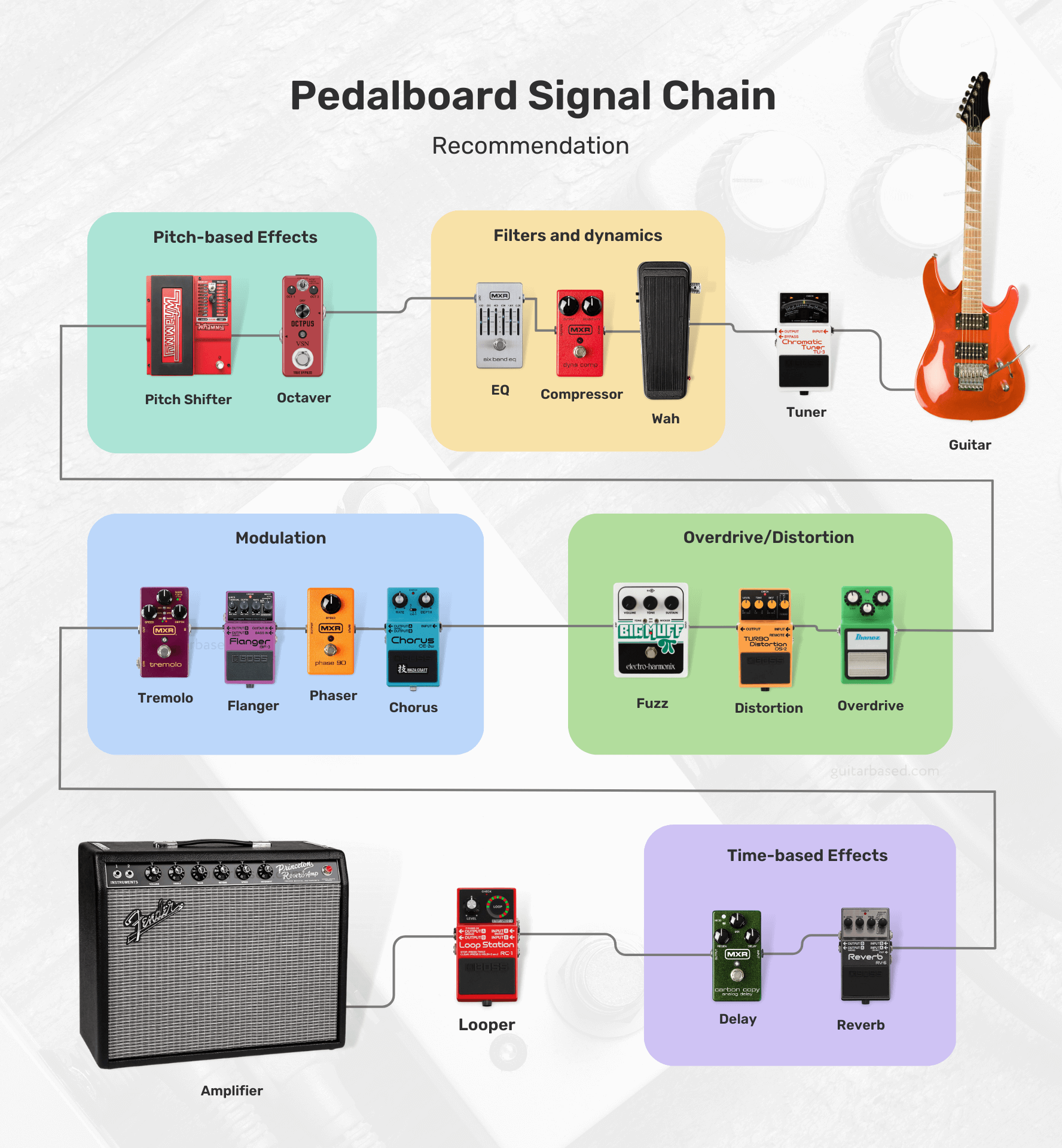
Feel free to swap the order of pedals, try different combinations, and test out unconventional setups until you find the one that works best for you.
For those interested, I’ll leave you with most of the possibilities that you’ll encounter and how to order them.
- Tuner
- Filters/Dynamics:
- Volume
- Wah
- Auto-Wah
- Compressor
- Noise Gate
- EQ (Equalizer)
- Pitch-based Effects:
- Octaver
- Harmonizer
- Pitch Shifter
- Overdrive/Distortion/Fuzz:
- Boost
- Overdrive
- Distortion
- Fuzz
- Modulation:
- Chorus
- Phaser
- Flanger
- Univibe
- Vibrato
- Tremolo
- Time-based Effects:
- Delay
- Echo
- Reverb
- Synth/Bitcrusher:
- Synth
- Bitcrusher
- Acoustic Simulator
- Multi-Effects
- Utility:
- Buffer
- A/B/Y Switcher
- MIDI Controllers
- Looper
Boutique vs. Mass-Produced pedals
Boutique pedals are generally built with higher-quality components and craftsmanship, resulting in better durability and longevity.
These pedals often feature unique and innovative designs, providing a wider range of tones and effects that may not be available in mass-produced options.
Here are a few examples of boutique pedals:

All the manufacturers also tend to have a more personal approach, with better customer service and the ability to customize pedals according to the user’s preferences.
However, boutique pedals are usually more expensive due to the smaller scale of production and the use of premium components.
Mass-produced pedals, on the other hand, are more affordable due to their larger scale of production and the use of cost-effective components.
These pedals are widely available and offer a range of popular effects, making them accessible to a larger audience.
Here are a few examples of mass-produced pedals:

The quality control for mass-produced pedals can vary depending on the brand and model, but many are reliable and offer good value for the money.
As for one of the downsides, you’ll find that mass-produced pedals may not have the same level of uniqueness or innovation as boutique options.
On the other hand, they may not provide the same level of customer service or customization options.
The choice between boutique and mass-produced pedals depends on your personal preferences, budget, and desired sound.
If you’re looking for unique tones, higher-quality components, and a more personal experience, boutique pedals may be the way to go.
But I would say, for those who are on a budget and need access to popular effects, mass-produced pedals might be a better fit.
It’s worth trying out both types to see which best suits your needs and playing style.
How much should you spend on a guitar pedal?
If I were in your position, I would first determine my budget and specific needs before deciding how much to spend on a guitar pedal.
For beginners, it might be more reasonable to start with affordable, mass-produced pedals to explore different effects without spending too much.
Guitar pedals can range in price from around $30 to over $400, depending on the brand, quality, and complexity of the effect.
As your skills and understanding of your preferred tone develop, you can gradually upgrade to higher-quality or boutique pedals.
One thing I would do is consider which effects are essential to your playing style and prioritize purchasing those first.
Allocating a larger portion of your budget to the most important pedals might be a wise choice, especially if you only need a few basic effects.
However, if you require a wide array of effects, you may want to consider more budget-friendly options or multi-effects units.
Keep in mind that higher-priced pedals often come with better build quality, unique features, and improved sound quality.
But I would also say that price is not always directly correlated with quality or suitability for your needs.
Sometimes, a more affordable pedal can deliver the exact sound you’re looking for, while a higher-priced option might not meet your expectations and are only expensive because of the brand reputation.
Can you use a guitar pedal with a bass guitar?
You can certainly use a guitar pedal with a bass guitar.
But it’s crucial to be aware that some guitar pedals may not be specifically designed to accommodate the frequency range of a bass guitar.
This could result in a less-than-ideal performance or an altered tone that might not be what you were expecting.
If you’re feeling adventurous and eager to experiment with your sound, don’t hesitate to connect your guitar pedals to your bass guitar.
This can be a fun way to explore different sonic possibilities, and you might even stumble upon some unique tones that complement your playing style perfectly.
Using a guitar pedal with a bass guitar may not always produce the desired results.
In some cases, the low-end frequencies might be lost, or the effect could sound too harsh or muddy.
To avoid these issues, you could consider looking into pedals that are specifically designed for bass guitars.
These pedals are engineered with the bass frequency range in mind, ensuring that your low-end remains intact and the effect sounds as intended.
In addition to bass-specific pedals, there are also multi-effects processors and pedals that cater to both guitar and bass players, offering a wide range of effects and tonal options.
These versatile units can be a great solution if you play both instruments and want a single device to cover your needs.
How to properly power your pedals?
When it comes to powering your pedals, you want to make sure you’re doing it right to avoid any noise issues or potential damage.
First, check each pedal’s power requirements, which you can usually find in the manual or on the pedal itself.
You’ll want to pay attention to the voltage (usually 9V, 12V, or 18V) and current (measured in milliamps or mA).
Now, you’ve got a few options for powering your pedals.
You can use individual power supplies or batteries for each pedal, but that can get messy and inconvenient.
I’d recommend going for a pedal power supply or an isolated power brick.

For example here are a few ones I recommend:
- Voodoo Lab Pedal Power 2 Plus Isolated Power Supply (My favorite)
- Rowin PW-1 Guitar Pedal Power Supply (Cheapest)
These babies can power multiple pedals at once, and the isolated outputs help prevent noise and ground loop issues.
Just make sure the power supply you choose can handle the voltage and current requirements of all your pedals.
When you’re connecting everything, use good quality power cables and keep them neat and tidy to avoid a tangled mess.
You might even want to use cable ties or cable organizers to keep everything in order.
In love with guitars, and gear; expert in all things music! Been writing about guitars for about 5 years and counting. Born in the ’90s. Alma Mater: University of Havana. Always curious, trying to understand the world. #TeamFender

